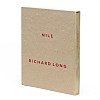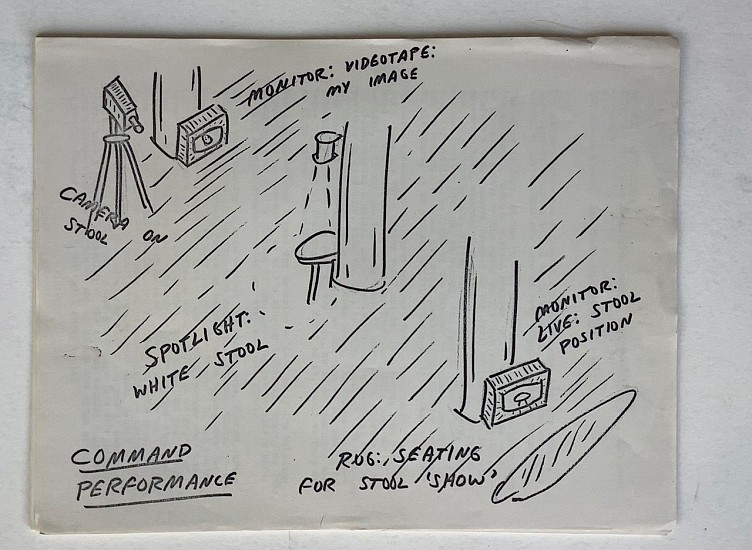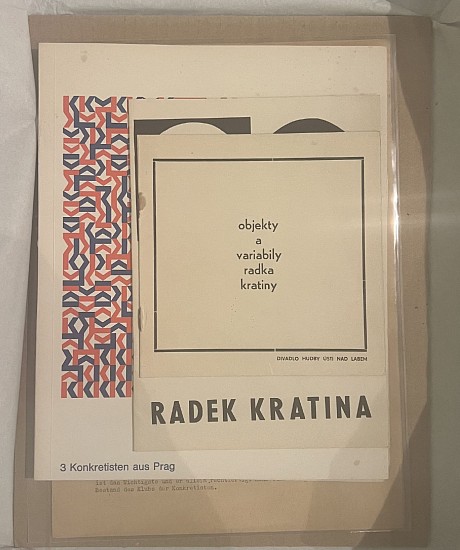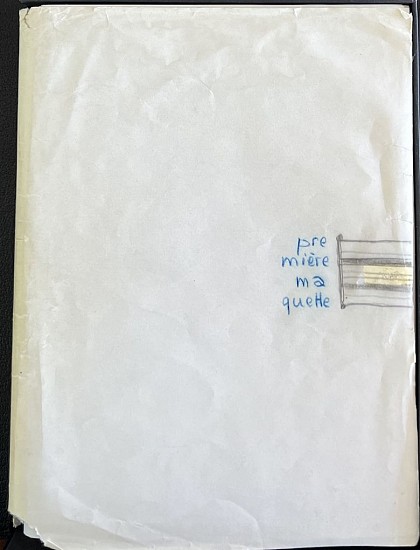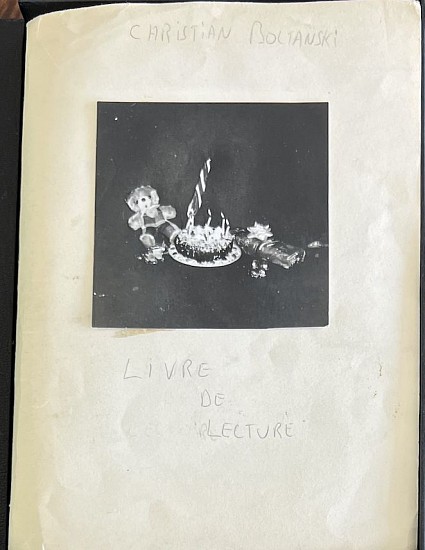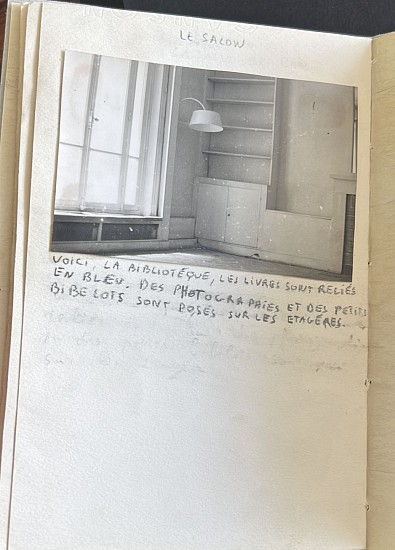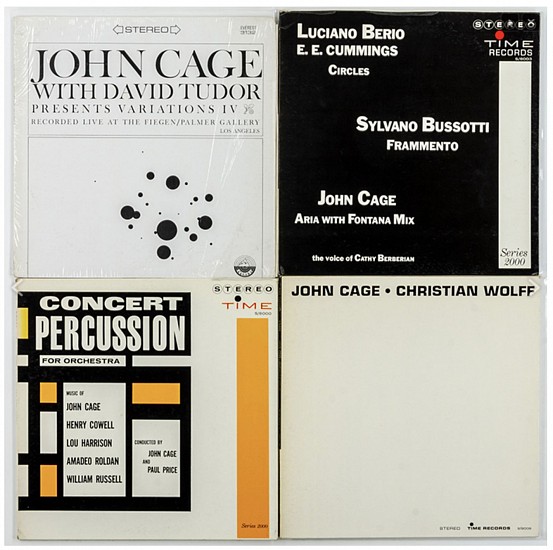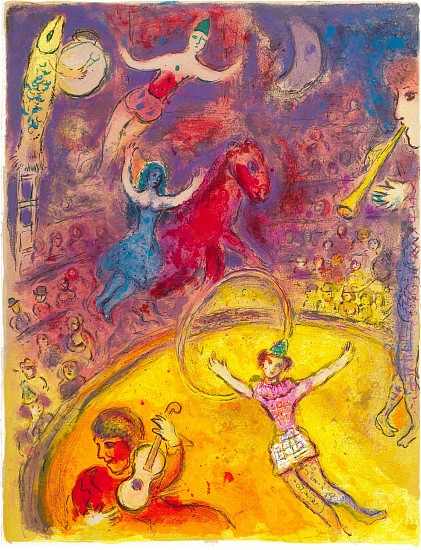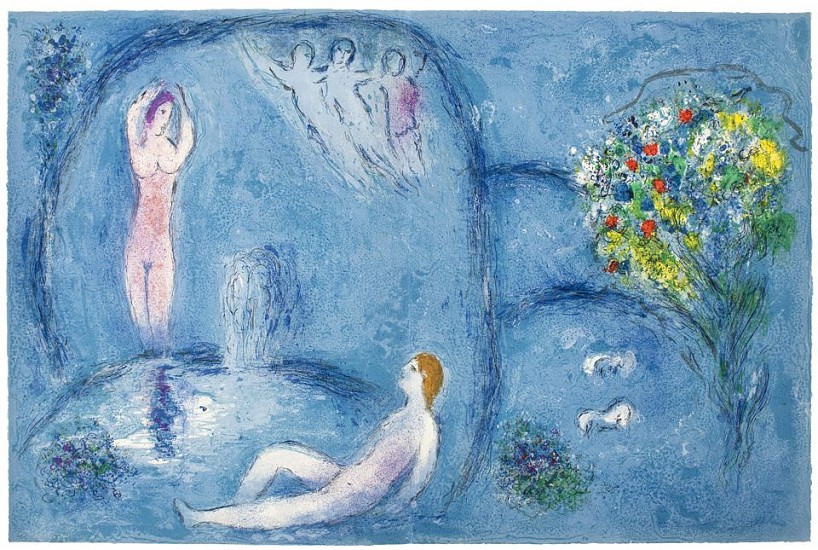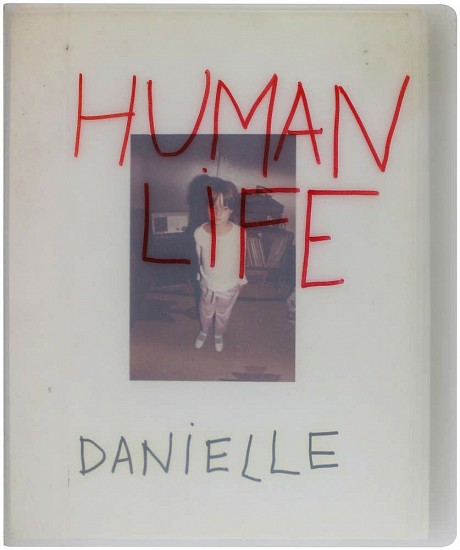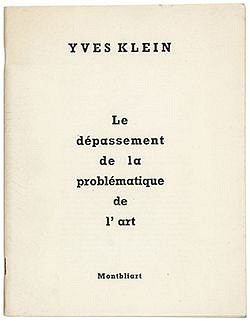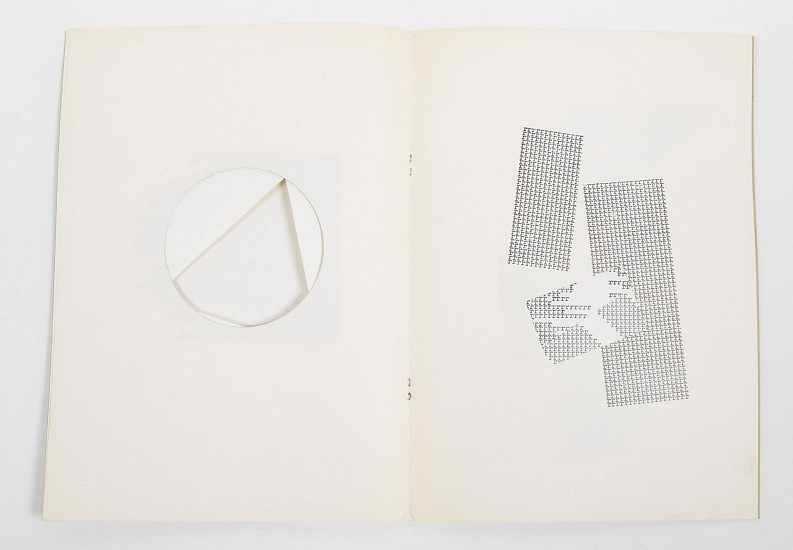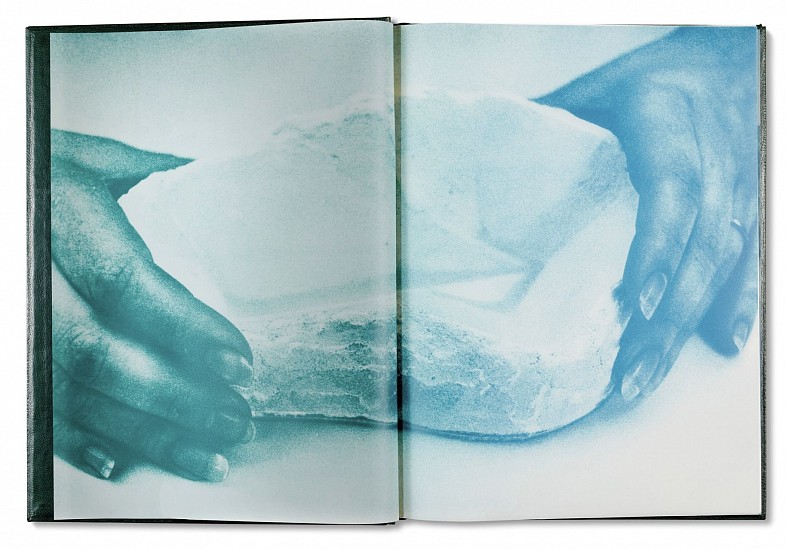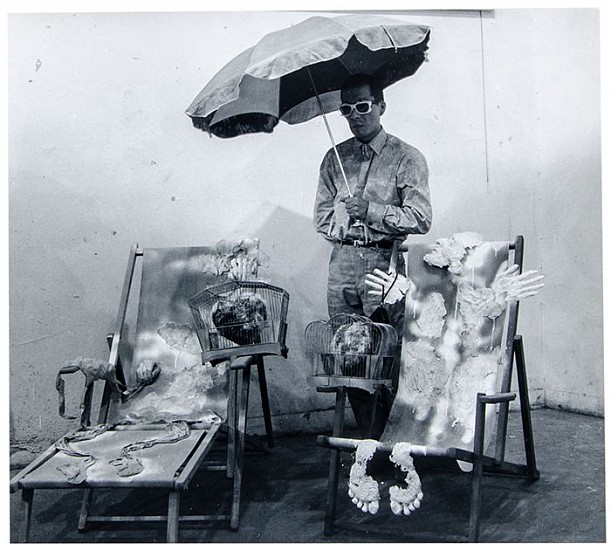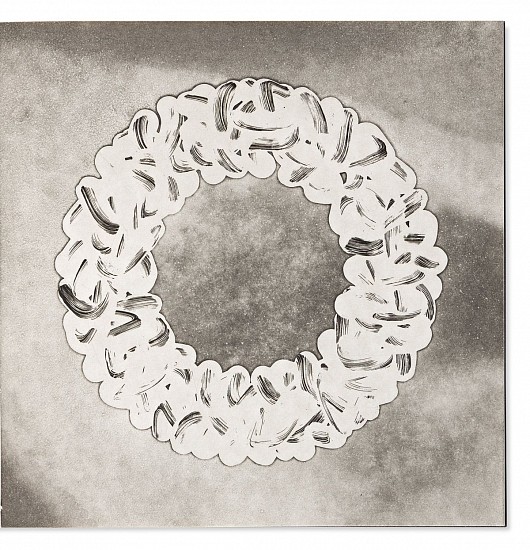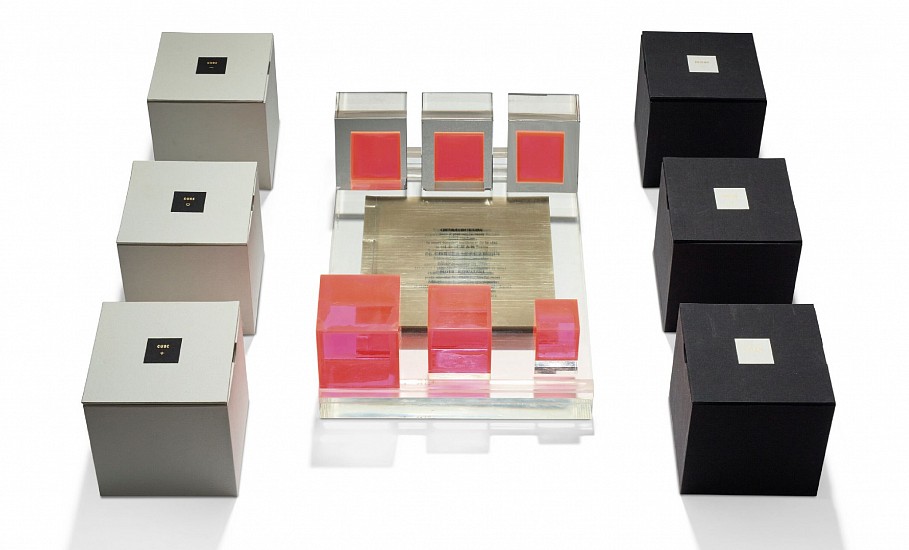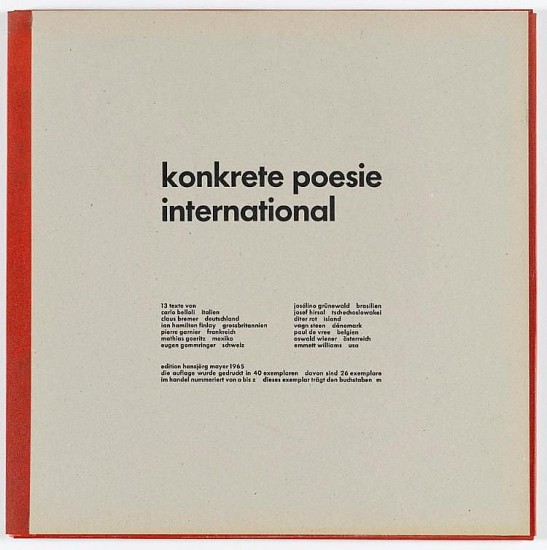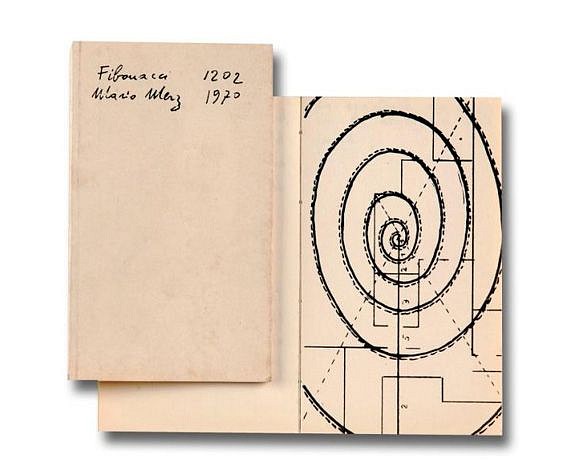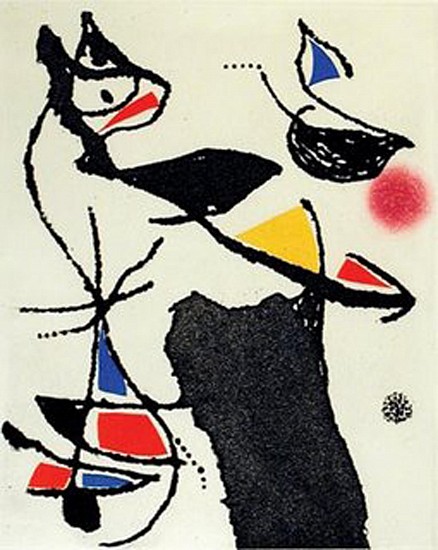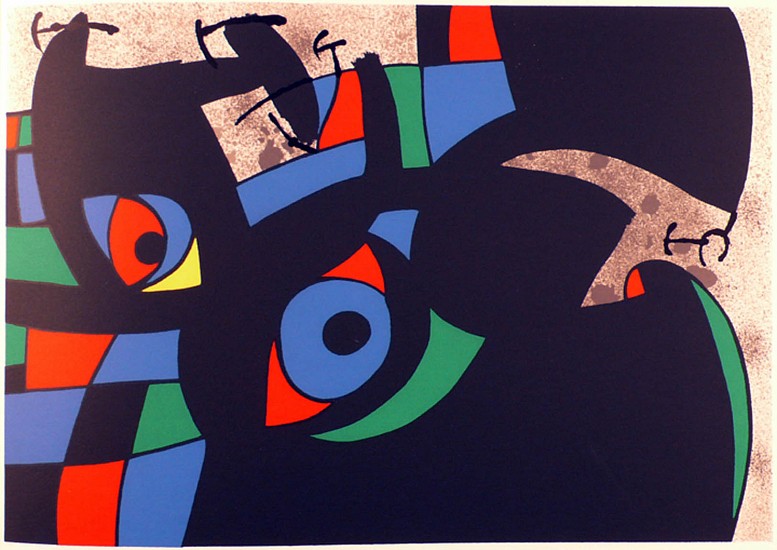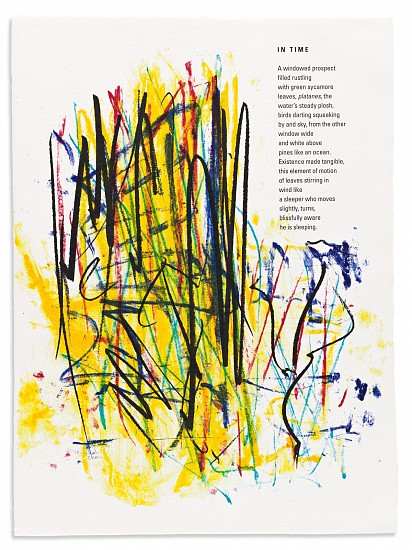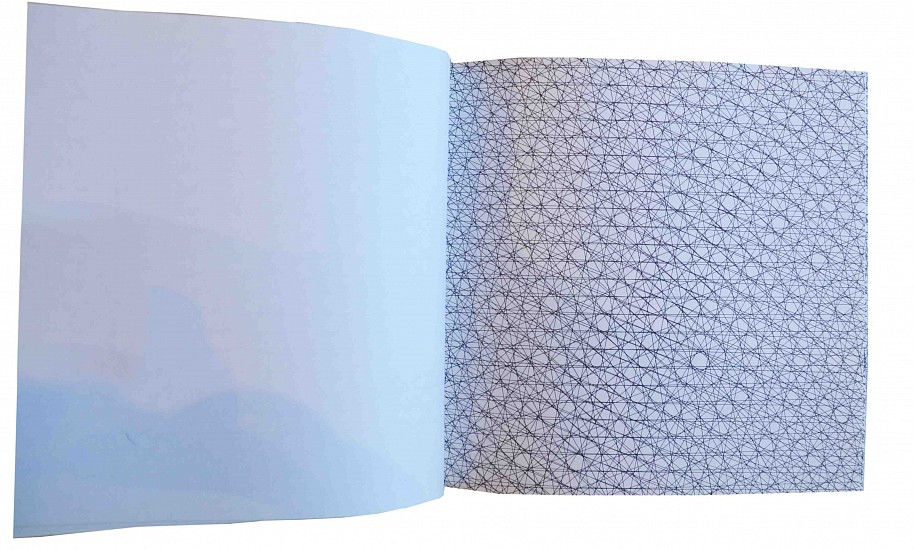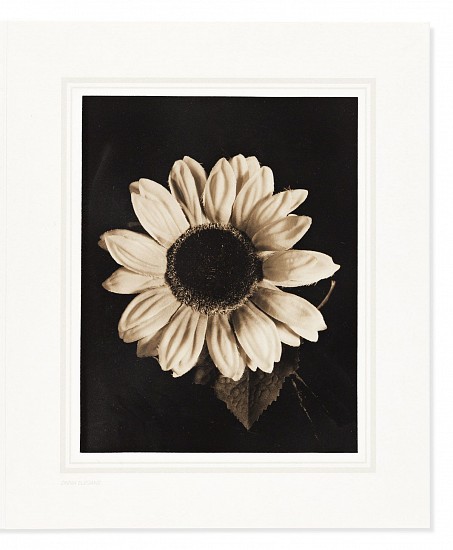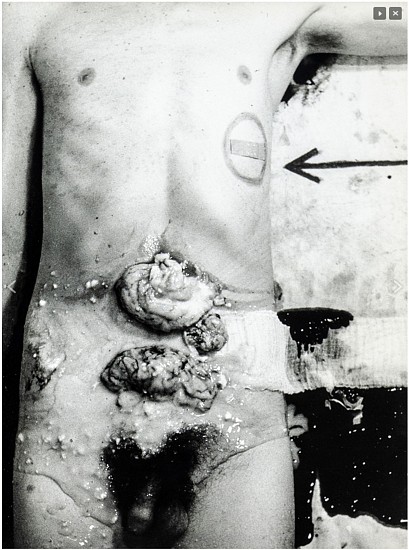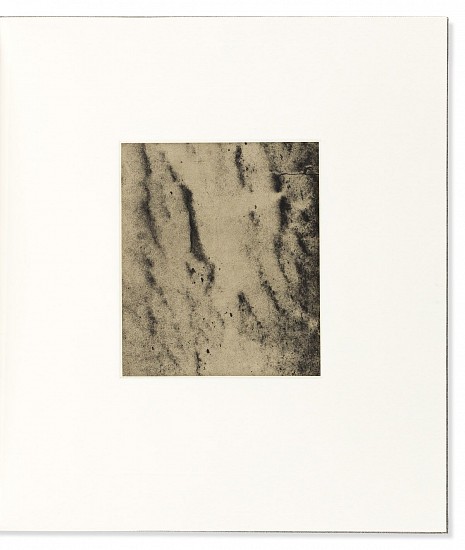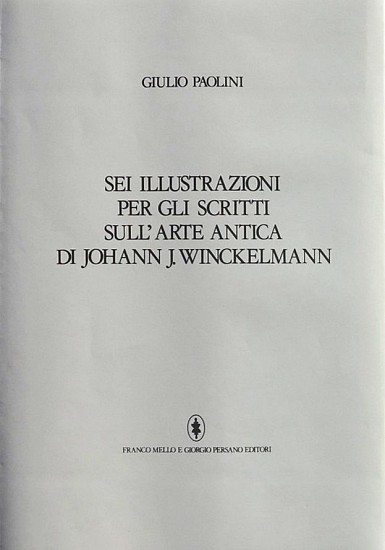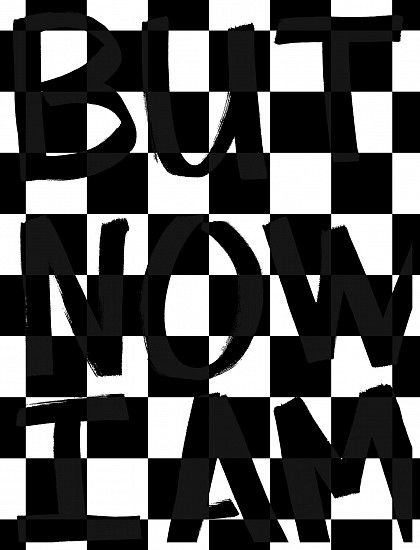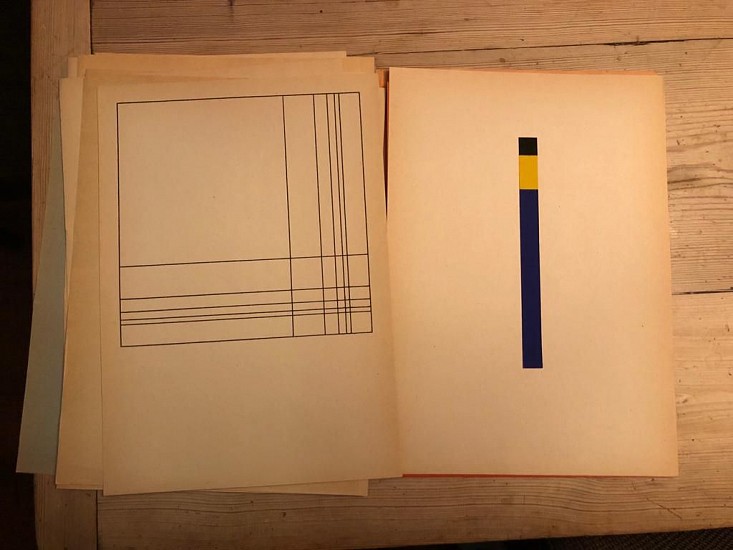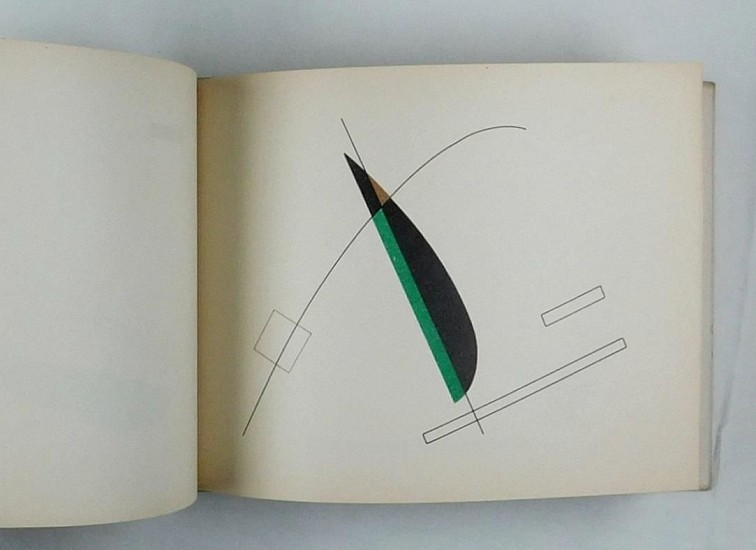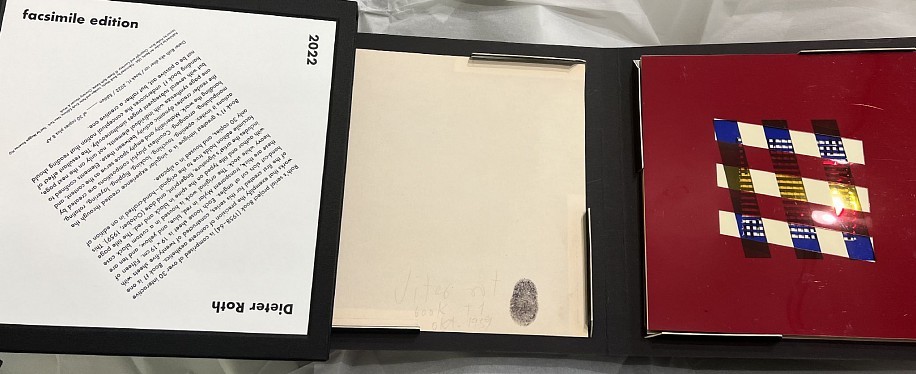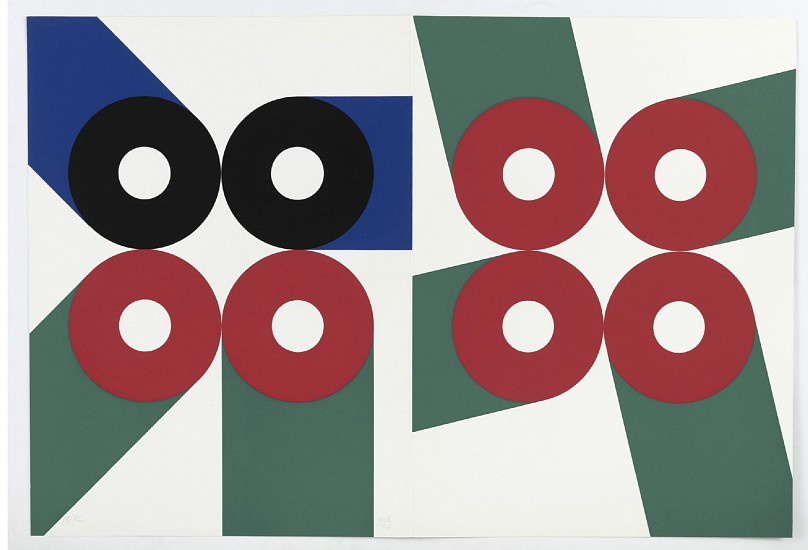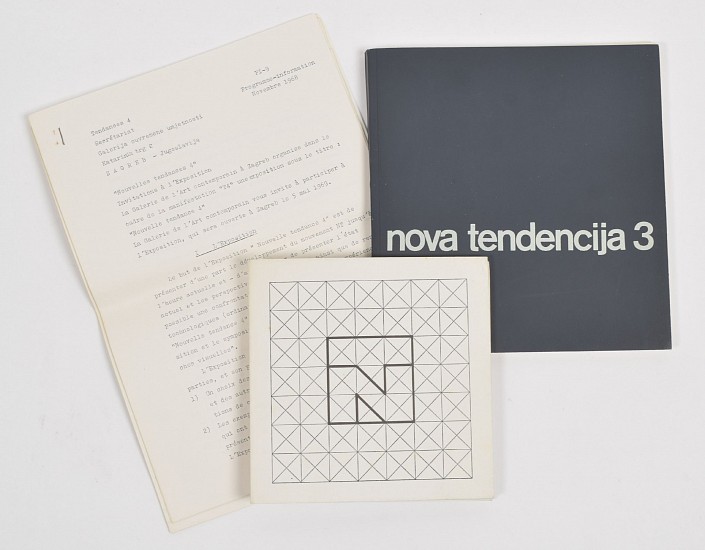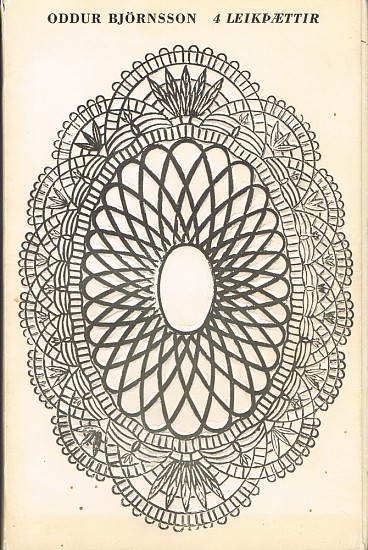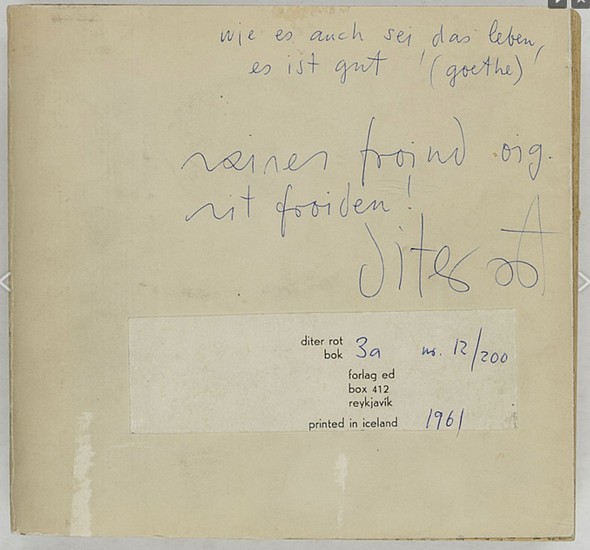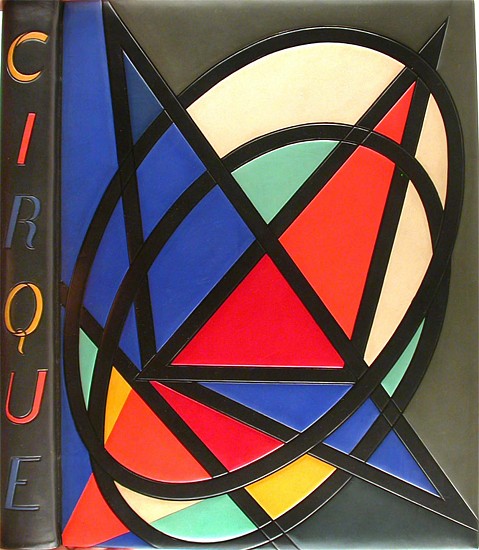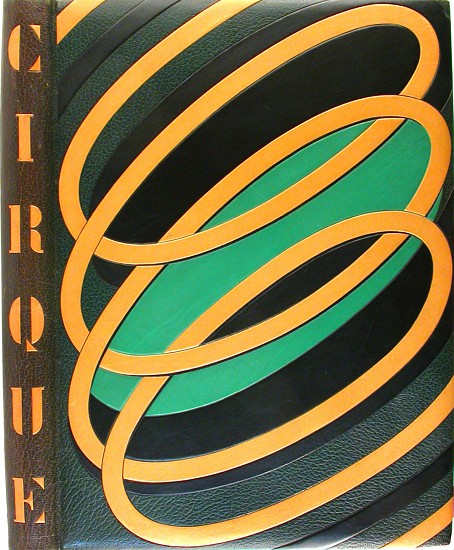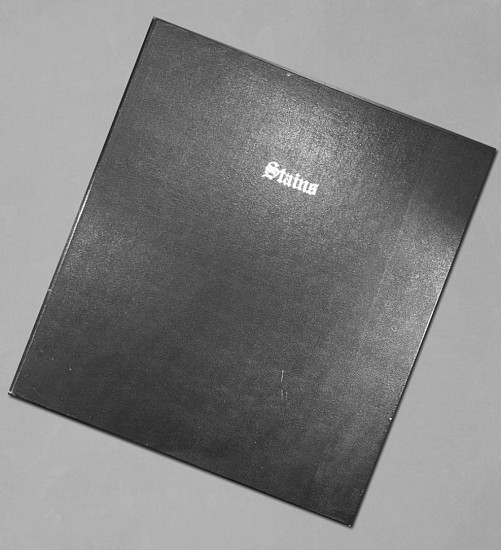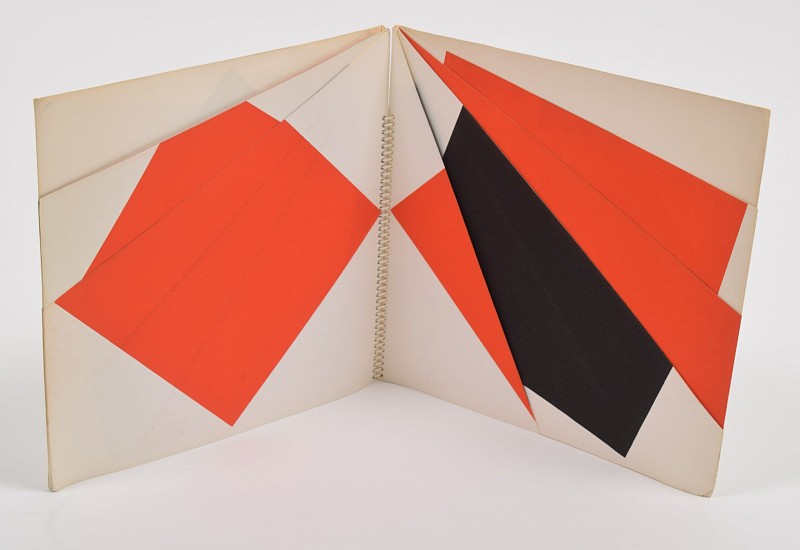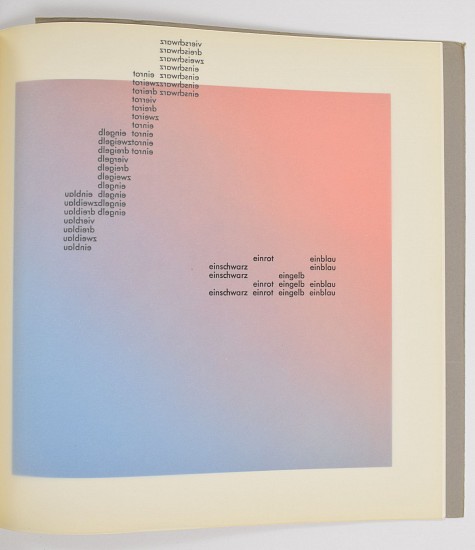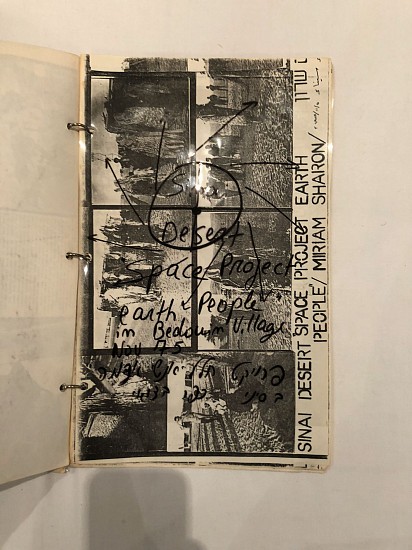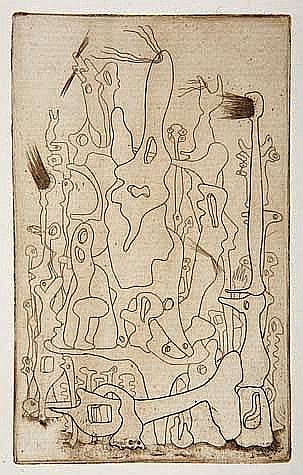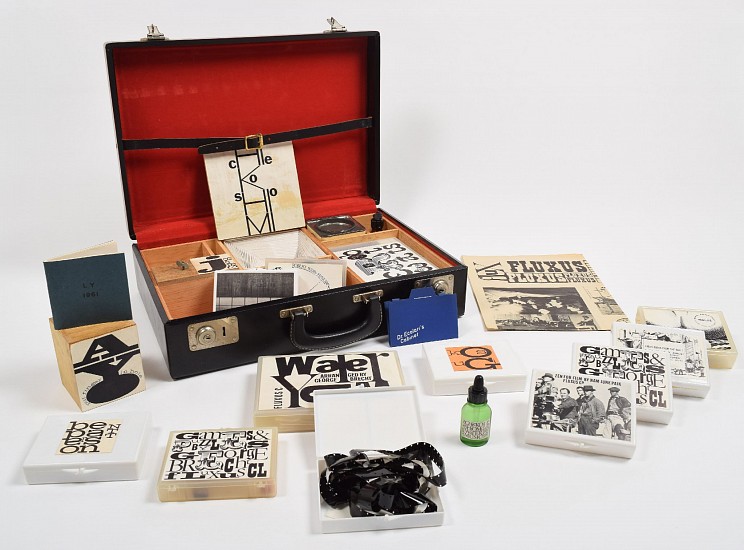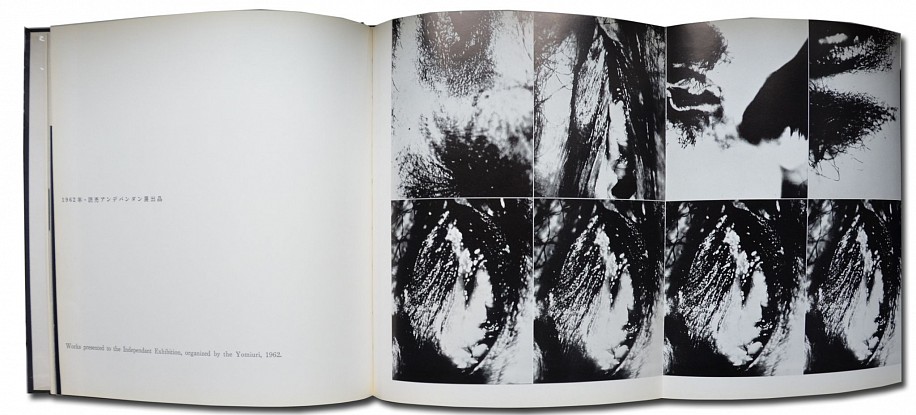New York Antiquarian Book Fair
Vito Acconci
A collection of early multimedia documentation and unique proposals, 1970 – 1983
13242-BK
1. Steps (Stepping-off Place). (New York). (Self-published). 1970. (28 x 21.6 cm). Three xerox typed flyers, each folded for mailing; printed recots only. Three original typed flyers for one of the earliest of Acconci performance pieces. Steps (Stepping-off Place) describes a series of repetitive actions which took take place at the artist’s apartment on Christopher Street in New York over a period of four separate months. The project is described on the flyer as such: “An 18-inch stool is set up in my apartment and used as a step. Each morning, during the designated months, i step up and down the stool at the rate of 30 steps a minute; each morning, the activity lasts as long as I can perform it without stopping … (The public can see the activity performed, in my apartment, any morning during the performance months. Whenever I cannot be home, I will attempt to perform the activity wherever I happen to be)â€. The length of time Acconci manages this activity each day of the month is listed on two the flyers. The activity was performed in February, April, July and November of 1970. Present here are the flyers for all but the July performance. Three unique proposals for multimedia installations. (1975). Three sets of stapled sheets, rectos only. Three original proposals by Vito Acconci for installations that remained unrealised. The proposals, each with original drawings, were mailed by Acconci to Ira Licht, then curator at the Museum of Contemporary Art Chicago, in April 1975. Licht was the organiser of the famous Bodyworks show in Chicago (March-April 1975) of which Acconci was a major participant. The three unique proposals each consist of a typed descriptive text (occasionally with corrections), stapled together with either one or two full-page sketches of the installation layout, executed in black-felt-tip pen. Shots in the Dark - “A structure 20 feet long, 3 feet wide, and the height of the existent room ceiling … the two walls are apainted black, inside and out; the entrance is covered by a black curtain. Inside, on the rear wall, is a slide projector on a shelf - it shoots at the viewer, projects an image on his body. Ther’s a tape Otherer, a speaker on the rear wall … the peaker addresses the viewer. My voice - the voice is crazy, like a voice in a fun house gone out of control†(this proposal has 2 original drawings attached) Snapshot - “A small black room or box … its entrance is covered with a black curtain - the room is free-standing, preferably near the middle of a room … Inside: a slide projector on the rear wall, facing the entrance - it shines on the viewer, on his face and chest - it puts him in the spotlight, on the spot. There’s a tape Otherer, the speaker on a side wall - like a whisper in the viewer’s ear. My voice - the voice is insinuating, cajoling, sneaky - it’s as if the viewer is having his snapshot taken, in a photo booth†(with single drawing attached) Beast Within (temporary title) - “A black box, 5 foot cube - free-standing, preferably near the center of the room. Entrance is covered with a black curtain. Inside the walls are white, but a green spotlight covers everything - there’s a cage-like structure composed of rope … the viewer could squeeze in, but with some difficulty. A tape Otherer, two speakers - one is in a louder voice, the other more whispering … My voice, changing tones: I admit to the viewer that I want to trap him - I want to trap him in memory, in history, in myth, in politics†(with single drawing attached). Original design sketches for Acconci’s installation at the Bodyworks exhibition, Museum of Contemporary Art, Chicago 1975. (1975). Notes (30 x 30 cm), folded; maquette (18 x 23 cm). Notes and sketches made by Acconci in pencil on a sheet of transparent crystal paper, providing design and installation instructions for his contribution to the Bodyworks show in Chicago. Includes notes on the construction of a panel facing a wall, and the use of pinned black paper and acetate sheets to cover the walls, with two small side and perspective view drawings. Accompanying the notes is a small-scale maquette for the interlocking acetate wall panels, here made from numbered and taped sections of crystal paper. Notes (30 x 30 cm), folded; maquette (18 x 23 cm). Was Here - original text proposal for a performance. (1975). (28 x 21.7 cm). Single sheet. Acconci’s initial notes on a proposed, yet apparently unrealised performance piece. Written in pencil on a single sheet of card, in his trademark all-capital letter script: “What I am structurally dealing with in this piece is making and breaking straight lines, similar to the planets lining up in 1975. There is almost always more than one thing going on at one time, seemingly unrelated to one another … at one point on the piece these three things are occurring: “ITT†is written in lights on the billboard, a voice on the tape Otherer is saying ‘I tee tee, I tee tee’, and on the video tape I’m seated making a gesture with a light bulb related to what catholics do when they finish praying.†[ The following six sets of performance documentation ( a – f ) were submitted by Acconci to Ira Licht in October 1976. Licht was then co-ordinator at the National Endowment for the Arts (NEA) in Washington, D.C. Of note, Acconci was to successfully gain the first of his NEA Fellowships in 1976. ] a. Ballroom. November 1973. Sheets (28 x 21.6 cm); photos (20.6 x 25 cm). 15 sheets printed rectos only, including 2 loose and the remaining stapled together in two tranches + two original black-and-white photographs. The last public performance of Acconci, ‘Ballroom’, took place in November 1973, at the Galleria Schema in Florence: “The situation is that of a dance hall: five sets of white tables and chairs are arranged in a circel around the ‘dance floor’ - three spotlights shine down from the ceiling onto the floor. In The background, a loop tape: my voice humming Al Jolson’s ‘Anniversary Song’ - the way you would hum something absentmindedly, while going about your business. I’m walking, shuffling, slowly, around the dance floor, from spot to spot. I’m turned inward - that is, it’s more that I’m reflecting on something rather than putting on a show.†Presented here is the original printed documentation regarding Acconci’s ‘Ballroom’ performance. Consists of a photostat of Acconci’s original drawing of the installation, noting the positions of the spotlights and audio tape machines, as well as the artist’s own positions within the space; a single sheet with Acconci’s typed artist statement regarding the work (on Sonnabend Gallery headed paper); one 10-page transcript of the audio performance, and another 3-page description of the second part of the performance. Also present are two original black-and-white photographs of Acconci performing the work. Each photograph measures 10 x 8 inch, the first with four stills from the first half of the performance, the other with six stills from the second half of the performance. Each photograph with the Sonnabend Gallery title label pasted to verso. b. Scenes from This Side of the Camp. November 1973. Sheets (28 x 21.6 cm); photo (20.6 x 25 cm). 19 sheets printed rectos only, including 3 loose and the remaining stapled together in three groups + one original black-and-white photograph. ‘Scenes from This Side of the Camp’, took place between November 1973 and February 1974, at the Galleria Contemporanea in Rome. The installation consisted of built constructions, audiotapes and slide projections: “The situation is that of a guerilla war-camp. In the middle, there’s a circle of sand-bags; inside the circle the floor is covered with saw-dust - and a place to gather in … To the right, there are four sleeping bags in a niche covered with sand and dirt; a saw-horse lies on its side, a slide projector positioned on top of it, like artillery … at the circle of sand-bags, there’s loop tape: I’m talking, humming - I’m alone, lulling myself to sleepâ€. Presented here is the original printed documentation regarding Acconci’s ‘Scenes from This Side of the Camp’ performance. Consists of a photostat of Acconci’s original drawing of the installation; a single sheet with Acconci’s typed artist statement regarding the work (on Sonnabend Gallery headed paper); two transcripts of the audio-tapes, one 3 pages in length, the other 10 pages; and a four-page list of the slogans on the projected slides. Also present is one original black-and-white photograph of Acconci performing the work. The photograph measures 10 x 8 inch, and has five stills from the performance. The photograph with the Sonnabend Gallery title label pasted to verso. c. Command Performance. January 1974. (28 x 21.6 cm). 14 sheets printed rectos only, including 2 loose and 12 stapled together. In ‘Command Performance’, a video work installed at the 112 Greene Street space in New York in January 1974, Acconci attempted to replace himself with the viewer. In the performance he lied on his back with the camera gazing down on him and began an incantation, attempting to seduce the viewer to take his place in the spotlight: "You're there where I used to be. I don't have to be there anymore. You can do it for me now... Oh, you didn't expect this, did you baby? You're used to the way it was." As the tape progresses, Acconci, humming and singing to himself, is driven further and further into his fantasy. "Now you're in the spotlight. You'll do everything I want, my little puppet, my little dancing bear." In the installation of Command Performance, the audience was confronted with an empty stool in a spotlight; Acconci, exhorting the viewer to take his place, was present only on a video monitor. Presented here is the original printed documentation regarding ‘Command Performance’. Consists of a photostat of Acconci’s original drawing of the installation, noting the position of the camera, stool, spotlight and monitor; a single sheet with Acconci’s typed artist statement regarding the work; and an 11-page transcript of the videotape Othering. d. Intermediaries (Sound-Track for a Self-Image). May 1974. Sheets (28 x 21.6 cm). 30 sheets printed rectos only, including 2 loose and the remaining stapled together. ‘Intermediaries (Sound-Track for a Self-Image)’, was an Acconci Installation at the Galleria Forma, Genoa, May 1974. The installation consisted of built free-standing walls within a gallery space and corridor, furniture, audiotape, and projected slides: “The room is treated as a projection booth, blown up out of proportion. There are three slide projectors in corners, intersecting each other and shooting images onto the walls - the image is large, it stretches up onto the ceiling, flows down to the floor. there are images of myself; they seem posed, somewhat studied … my face is in close-up, caught from below, it’s too white, as if I’ve been trapped, or as if I’ve become a ghost. It’s the corridor, at the side, that provides a voice, a sound-track. There are four more free-standing white walls, extending diagonally from the actual walls, down the length of the corridor - they make a slace you have to weave around, go in and out of. The space is used, literally, as a track of sound: there’s a stereo tape Otherer - each speaker is placed on a wall which, in turn faces an empty wall, as if to buffer the soundâ€. Presented here is the original printed documentation regarding Acconci’s ‘Intermediaries’ installation. Consists of a photostat of Acconci’s original drawing of the installation; a single sheet with Acconci’s typed artist statement regarding the work; and a 27-page transcript of the audiotape Othering. e. Views of a Forced Landing. May-June 1974. Sheets (28 x 21.6 cm); photo (20.6 x 25 cm). 16 sheets printed rectos only, including 2 loose and the remaining stapled together + one original black-and-white photograph. ‘Views of a Forced Landing’, was Acconci’s contribution to the group exhibition Art now 74: a celebration of the American arts, held at the John. F. Kennedy Center for the Performing Arts, Washington, D.C., May 30 through June 16, 1974. The installation consisted of built wooden bunker with stairs and netting, spotlight, audiotape, and projected slides: “The situation is war. The wooden structure resembles an army bunker - eight feet high, eight feet long, eight feet wide … Entrance is around the back, a doorway two feet wide and less than six feet high. So you have to duck to go in, and immediately you’re faced with a choice: one step in, right in front of you, is a stairway that goes up to the top … if you choose not to go up, you can squeeze around the stairs, go under some overlapping sheets of mosquito netting - the feel here is vaguely tent-like, possible swamp-like - beneath the netting there’s a mat to fall into, lie on, crawl over into a corner. There’s a tape Otherer … it’s a kind of opera, as set of motifs - the sound switches from speaker to speaker, from low place to high placeâ€. Presented here is the original printed documentation regarding Acconci’s ‘Views of a Forced Landing’ installation. Consists of a photostat of Acconci’s original drawing of the installation; a single sheet with Acconci’s typed artist statement regarding the work; and a 13-page transcript of the audiotape Othering. Also present is one original black-and-white photograph of the installation. The photograph measures 10 x 8 inch, and is divided into five stills. The photograph with the Sonnabend Gallery title label pasted to verso. f. Memory Box III: (Vanishing Point). July-August 1974. Sheets (28 x 21.6 cm); photo (20.6 x 25 cm). 20 sheets printed rectos only, including 2 loose and the remaining stapled together + one original black-and-white photograph. ‘Memory Box III: (Vanishing Point)’, was Acconci’s contribution to the group exhibition 'Project '74. Aspects of International Art in the Early 1970s' held at the Kunsthalle and Kölnischer Kunstverein in July/August of 1974 in Cologne. The exhibition was staged to mark the 150th anniversary of the Wallraff-Richartz-Museum. Acconci’s installation consisted of built wooden construction with audiotape, and projected slides: “A wedge-shaped wooden structure, 25 feet long, 7 feet by 7 feet at the front and tapering off to 2.5 feet at the back, on the floor. Inside there’s a funnelling toward the other end: a foam mattress lies at the back, squeezed in between the converging sides. There’s an audiotape, my vioce at the head of the mattress, speaking in the first person; this is a place meant for me - a place where I could drive myself under, make myself passive, receptive. The walls lose their soloidity: a slide projector, at the head of the mattress, projects slides up acorss the ceiling, changing quickly, stretching from back to front, washing over the sidesâ€. Presented here is the original printed documentation regarding Acconci’s ‘Memory Box’ installation. Consists of a photostat of Acconci’s original drawing of the installation; a single sheet with Acconci’s typed artist statement regarding the work; and an 18-page transcript of the audiotape Othering. Also present is one original black-and-white photograph of the installation. The photograph measures 10 x 8 inch, and is divided into five stills. The photograph with the Sonnabend Gallery title label pasted to verso. (Proposal for): Umbrella City. 1982. (28 x 21.7 cm). 20 sheets printed rectos only, stapled together in two groups + one original signed typed letter. Vito Acconci’s xeroxed proposals for his Umbrella City installation at Documenta VII in the Friedericianum Museum, Kassel in 1982. Includes sheets of typed explanatory texts as well as xeroxed drawings by Acconci. Consists of a copy of the 13-page original proposal, as well as a 7-page revised proposal. The need for two proposals is explained by the presence of a covering letter from Acconci addressed to Ira Licht, then Director of the University of Miami's Lowe Art Museum. This original typed letter, dated May 26, 1982, is signed in pen by Acconci. In the letter Acconci describes the quandary he finds himself in: “For this year’s DOCUMENTA, I was scheduled to an existent piece indoors and a new piece outdoors. The budget for the outdoor piece was $10,000. The piece I proposed was UMBRELLA CITY, the plan of which I’ve enclosed with this letter. Recently I was informed by DOCUMENTA that they had gone over budget, there was no money available for the new piece. Then that staement was revised: there was $1500 available. In my desire to get the new piece done, I decided I would try it: do one of the houses of the Umbrella City or, more likely, do a revised and smaller version [sic] of the city itself (I’ve enclosed this plan also). but the problem is: it’s clear that the piece can’t be done well for $1500â€. Acconci goes on to ask Mr Licht for $5000 to complete the project, explaining that, in return, the person giving the money would end up being the owner of the piece after the show. Acconci hopes Mr Licht would forward this request to Martin Margulies, a major Floridian art collector. It is not know if any monies were given, with Acconci himself noting it was “a very far-fetched propositionâ€. However, it is interestong to note that the smaller revised proposal was the one that was eventually constructed at Documenta. Biographical flyer for: Way Station I (Study Chamber). (Middlebury, VT). 1983. (35.5 21.7 cm). Single sheet, printed both sides, folded. Acconci, famed initially for his videos and performance pieces, was invited to Middlebury College, Vermont for the 1982-83 school year to teach a class titled “Art in Public Places.†He and his students jointly assembled “Way Station I (Study Chamber),†an intricate work roughly the size of a phone booth that was installed along a walkway linking dorms and academic buildings. The work sparked immense controversy on the college's campus, and was eventually set on fire and destroyed in 1985. This printed flyer, produced for the work’s installation, contains a list of Acconci’s solo exhibitoins, his wrtings, plus a short biographical essay by the artist himself.
Price Upon Request
Artist Collective
Prague Concretists' Club Collection, 1967
13374-BK
11 1/2 x 8 1/4 in. (29.4 x 21 cm)
Appeal to the concretists. A call to the concreteists. Appel a tous les concretistes. Výzva konkrétistum. Probably Prague, August 30, 1967. 10 loose typewritten sheets. The Klub Konkrétistov (Concretists' Club) was founded in Prague in 1967 and originally consisted mainly of representatives of Czech and Slovak Constructivist art. The most important representatives included Z. Sýkora (1920-2011), Arsén Pohribný, Jirà Valoch, Jirà Hilmar, Radek Kratina, Eduard Antal (1929-2011), Stefan Belohradský (1930-2012), Jarmila Cihánková, Alojz Klimo (1922- 2000), Tamara Klimová (1922-2004) and A. Cepka. – “This view brings the Cheslovak Concretists closer to the groups GRAV in Paris, Zero in Düsseldorf, Null with the center of international activity, the Stuttgart group, then the English and American Structuralists, the Italian groups T, Enne and Gruppo 1 in Rome, Gutai in Tokyo, Noigandres in Sao Paolo, the group of kinetists in Moscow and finally the individually creative concretists... The club of concretists unites visual artists, architects, industrial designers, poets, musicians and film people. He has local groups in Ostrava, Bratislava, Brno and Prague.†(1st and 2nd sheet). – With texts by Karel Trinkewitz, Radek Kratina, Arsen Pohribny, Dalibor Chatrny, Tamara Klimová, Jan Dusek, Jarmila Cihánková, Eduard Ovcacek, Jiri Valoch, Jiri Hilmar and Jiri Hampl. – Browned due to paper, continuous horizontal crease mark in the middle. – Added: 3 exhibition catalogs of the Konkretisten. I. Club Konkrétistov. Catalog for the exhibition in the Výstavný Pavilón Zsvu, Bratislava, September 19 - October 19, 1969. – II. Club of Concreteists Prague. Catalog for the exhibition in the gallery Mahlerstrasse 13, Vienna, July 1969. – III. 3 concretists from Prague. (Hilmar, Kyncl and Rajlich). Catalog for the exhibition in the Bochum Museum, January 20-February 25, 1973. - Covers a bit stained, otherwise in good condition. – Added: 2 exhibition catalogs by Radek Kratina. I. Objectively a variable. For the exhibition in divadlo hudby usti nad labem, around 1967. – II. Objecty a variabily 1963-1966. For exhibition in Oblastni Galerie Vysociny v Jihlave, around 1967. – Good condition.
Price Upon Request
Christian Boltanski
First original maquette for: Les Modèles. Cinq relations entre texte et image., 1979
13454-BK
8 5/8 x 6 1/4 in. (22 x 16 cm)
Paris. (The artist). Sheets loose in a paper wrapper, with the title “première maquette†handwritten in blue pencil on front, and with
the artist’s pencil rendering of a buckle and strap closing mechanism.
Les Modèles was an artist's book/catalogue published by cheval d’attaque in 1979 on the occasion of Boltanski’s exhibition in the Maison de la Culture de Chalon-sur-Saone. In the published catalogue, five earlier book works by Boltanski were reprinted, with three having being published previously, whilst for the two other books, this was the first time they appeared in print.
The books reproduced in the catalogue were: Recherche et présentation de tout ce qui reste de mon enfance; Tout ce que je sais d'une femme qui est morte et que je n’ai pas connue; L’appartement de la rue de Vaugirard; 10 portraits photographiques de Christian Boltanski, 1946-1964; and Les Histoires.
Here is Boltanski’s first handmade maquette for Les Modèles consisting of 67 loose sheets, 22 x 16 cm format, and includes the handwritten titles and legends as well as all the original photographs that composed some of Boltanski's earliest artist books.
Collation as follows:
11 preliminary sheets, including handwritten half-title, title, and collaged publisher’s imprint;
Recherche et présentation de tout ce qui reste de mon enfance - handwritten title and 8 original silver print photographs (16.8 x 11 cm), cut and glue-mounted on sheets of Vidalon paper, each photograph framed in pen. ‘Recherche et présentation de tout ce qui reste de mon enfance’ was Boltanski’s first artist’s book, originally published in 1969 utilizing photocopies of the same photographs presented here in the maquette. The photographs include a class photo in which Boltanski features in the upper row, second from the left, a piece of his sweater, a shirt etc. In reality, several of these allegedly personal relics belonged mostly to his brothers and nephews;
Tout ce que je sais d'une femme qui est morte et que je n’ai pas connue - three preliminary leaves including handwritten title & 5 offset printed black-and-white photographic images pasted onto Vidalon sheets, handwritten numbering in pencil beneath. Originally self-published by Boltanski in 1970, these five images reproduce photos of an anonymous family (the photos had been given to Boltanski by the Colombian artist Luis Caballero, who had found them in his studio);
L’appartement de la rue de Vaugirard - preliminary leaf with handwritten title, blank leaf & 10 original silver print photographs (each 7 x 10 cm), cut and glue-mounted onto sheets of Vidalon paper, each sheet numbered in pencil. The photographs were taken from a film shot by Boltanski in an empty apartment on Rue de Vaugirard;
10 portraits photographiques de Christian Boltanski, 1946-1964 (originally published 1972) - two preliminary leaves, one with handwritten title, blank leaf & 9 original silver print photographs (each 14 x 9.8 cm), cut and glue-mounted onto sheets of Vidalon paper, each sheet numbered in pencil. With this series of photographs Boltanski in fact got strangers and friends’ children to pose, except for the last photo which is alleged to show the artist at the age of twenty, when he was in fact twenty-eight;
Les Histoires - two preliminary leaves, one with handwritten title, & 9 original silver print photographs (each 6.5 x 9 cm), cut and glue-mounted onto sheets of Vidalon paper. Each photograph framed in pen, and each sheet numbered in pencil. Here Boltanski utilizes a series of photographic images from a children’s story book, here presented devoid of the artist’s deadpan text captions which were to accompany each photograph in the final published version.
[Ref. Bob Calle - Christian Boltanski Artist’s Books 1969-2007, pp. 12, 16, 26/27, 30/31, 33 (original editions of the five books); p. 124 (reference for Les Modèles)].
Sold
Christian Boltanski
Maquette for: Les Modèles. Cinq relations entre texte et image., 1979
13455-BK
7 3/4 x 4 7/8 in. (20 x 12.4 cm)
Paris. Sheets loose in a paper wrapper, with the author’s name and the title “Livre de Lecture†handwritten in pencil on front, together with a pasted down original silver print photograph depicting a still-life from a children’s party.
Les Modèles was an artist's book/catalogue published by cheval d’attaque in 1979 on the occasion of Boltanski’s exhibition in the Maison de la Culture de Chalon-sur-Saone. In the published catalogue, five earlier book works by Boltanski were chronologically reprinted, with three having being published previously, whilst for the two other books, this was the first time they appeared in print.
The books reproduced in the catalogue were: Recherche et présentation de tout ce qui reste de mon enfance; Tout ce que je sais d'une femme qui est morte et que je n’ai pas connue; 10 portraits photographiques de Christian Boltanski, 1946-1964; L’appartement de la rue de Vaugirard; and Les Histoires.
Presented here is a preliminary handmade maquette for Les Modèles, constructed by Boltanski who in fact gave it the title of a “livre de Lecture†or reading book. It consists of 28 lined graph cards, 20 x 12.4 cm format, and includes the handwritten half-titles and page-numbering, as well as collaged printed texts and original photographs that composed some of Boltanski's earliest artist books.
Collation as follows:
1 preliminary sheet of Vidalon paper with titles in pencil and pasted-down original photograph (5 x 9.5 cm) showing a child’s toy beach ball; half-title on lined graph paper, with titles in pen and pasted down silver print photograph; Recherche et présentation de tout ce qui reste de mon enfance - handwritten title and 8 original silver print photographs (each approx. 12.4 x 8.4 cm), cut and glue-mounted onto four sheets of graph card. ‘Recherche et présentation de tout ce qui reste de mon enfance’ was Boltanski’s first artist’s book, originally published in 1969 utilizing photocopies of the same photographs presented here in the maquette. The photographs include a class photo in which Boltanski features in the upper row, second from the left, a piece of his sweater, a shirt etc. In reality, several of these allegedly personal relics belonged mostly to his brothers and nephews;
Tout ce que je sais d'une femme qui est morte et que je n’ai pas connue - handwritten title & 5 offset printed black-and-white photographic images cut and glue-mounted onto five sheets of lined graph card. This maquette also includes Boltanski’s printed texts which accompany each of the images (the sections of printed text are cut and pasted onto versos of each card). Boltanski’s deliberately neutral comments describe each of the pictures as if it was a certified report. Originally self-published by Boltanski in 1970, the five images reproduce photos of an anonymous family (the photos had been given to Boltanski by the Colombian artist Luis Caballero, who had found them in his studio);
10 portraits photographiques de Christian Boltanski, 1946-1964 (originally published 1972) - handwritten title, blank leaf & 7 (of 9, seemingly lacking page 31/32) offset printed black-and-white photographic images cut and glue-mounted onto four sheets of lined graph card. Beneath all but one of the images Boltanski has also crudely cut and pasted his printed captions. With this series of fake autobiographical photographs, Boltanski in fact got strangers and friends’ children to pose for the images;
L’appartement de la rue de Vaugirard - handwritten title and 8 (of 10) original silver print photographs (each approx. 5.9 x 8.3 cm), cut and glue-mounted onto five sheets of lined graph card. The photographs were taken from a film shot by Boltanski in an empty apartment on Rue de Vaugirard;
Les Histoires - handwritten title, & 10 original silver print photographs (each approx. 6 x 8 cm), cut and glue-mounted onto six sheets of lined graph card (includes an extra photograph, with the final published version of the book only utilizing nine photographs). Boltanski here utilizes a series of photographic images from a children’s story book. The maquette also includes the artist’s deadpan text captions which were to accompany each photograph in the final published version, here handwritten in pen beneath each photograph.
[Ref. Bob Calle - Christian Boltanski Artist’s Books 1969-2007, pp. 12, 16, 26/27, 30/31, 33 (original editions of the five books); p. 124 (reference for Les Modèles)].
Sold
Christian Boltanski
Original maquette for: L'Appartement de la rue de Vaugirard. (Handwritten title on front wrapper: Ces genres élémentaires. Florilège. Livre de lecture et de divertissement par Christian Boltanski)., 1973
13453-BK
8 1/4 x 5 7/8 in. (21 x 15 cm)
Stitched into later grey suede-covered wrappers, boxed. With nine original silver print photographs, eight of which measure 8 x 12 cm, with the additional photograph pasted to front cover measuring 8.3 x 8.3 cm.
The unique handmade maquette by Christian Boltanski for his early artist’s book “L'Appartement de la rue de Vaugirardâ€. The maquette consists of 12 pages of thick Vidalon paper, on which are pasted nine hand-cut original silver print photographs by Boltanski. The first image, pasted onto the maquette’s front cover, is of a paper streamer and face mask, whilst the other eight photographs are stills from a film (16mm - black and white) which was shot in the artist's old flat in the rue de Vaugirard in May 1973. Boltanski has titled each photograph in pencil above, and the artist’s handwritten texts below describe a once magnificent life in these now empty rooms. The texts describe furniture and objects which are simply not there, thus evoking a conventional, comfortable life which is now lost. Interestingly Boltanski has clearly agonised over the texts accompanying the photographs, as is evident in the somewhat inadequate eradication of earlier pencil texts with a rubber eraser, and the subsequent rewriting of the lines of text.
The book of which this is the maquette was not actually published until 1991, and then only as part of the boxed set of "Livres" published by the Association française d’action artistique (AFAA).
Sold
Original maquette for: L'Appartement de la rue de Vaugirard. (Handwritten title on front wrapper: Ces genres élémentaires. Florilège. Livre de lecture et de divertissement par Christian Boltanski). | 1973 | Zucker Art Books
John Cage
Musica presents the music of John Cage. White Label. White album cover with title label mounted, 1958-1966
13368
John CAGE. A Collection of Vinyl Otherings. c.1958 - 1966. Musica Presents The Music Of John Cage - a privately pressed vinyl, with white labels and printed title labels affixed to both sides. Housed in the original card sleeve again with title information label pasted to front. Although many of these Otherings appear on later Others, this mythical Other, probably privately issued in the late 1950s, includes the first published Otherings of some Cage compositions: 4 Sonatas For Prepared Piano, Construction No. 1 In Metal, Music For Carillon, Imaginary Landscape No. 1, Wiliams Mix, and Excerpt From Concert For Piano And Orchestra. Conductor on the Otherings was Carl Bjornsson, with Tove Ullman on the carillon, and Gunnar Westberg on piano; Concert Percussion For Orchestra. (Time Others, 1961). Includes John Cage’s Solo for Prepared Piano, Trio (Tom-Toms, Pod Rattle); Luciano Berio, E. E. Cummings. Circles. Sylvano Bussotti, Frammento. John Cage, Aria With Fontana Mix. (Time Others, 1962). Fontana Mix is a piece for magnetic tape, consisting of electronic tape manipulation and concrete sound material, created and realized by Cage; John Cage, Christian Wolff. (Time Others, 1963). Includes Cartridge Music (1960), Duo for Violinist and Pianist (1961), Summer for String Quartet (1961), and Duet II for Horn and Piano (1961); John Cage With David Tudor presents Variations IV. (Everest Others, 1966). From a live performance at the Feigen-Palmer Gallery, Los Angeles.
Price Upon Request
Marc Chagall
Le Cirque (The Circus), 1967
17
17 5/8 x 13 1/2 in. (45 x 34.5 cm)
Paris: Tériade. The complete set of 38 lithographs (23 in colors), on Arches paper, the full sheets, loose (as issued), in- and hors-texte, title page, text in French and justification, within original paper wrapper, beige cloth-covered boards with title stamped in gilt on the spine and matching slipcase. This copy comes MINT wrapped in the original papers from the publisher. Edition # 4 of 250.
Price Upon Request
Marc Chagall
Daphnis and Chloé, 1961
176
16 1/2 x 12 1/2 in. (42 x 32 cm)
Paris: Tériade. Folio, 2 vols., 42 original lithographs in color. Loose as issued in original portfolio box. Edition limited to 270 copies on Arches paper, signed by the artist. Chagall's most famous work which transcribes the ancient Greek romantic story into vibrant, dream-like scenes. Edition of 250 plus XX hors commerce. This is copy No. XII of the hors commerce.
Price Upon Request
Barbara Ess
Human Life, 1979
10813-BK
11 x 8 in. (27.9 x 20.3 cm)
[N.p.: Self-published, c. 1979]. Unique artist's book. Quarto. Original photographs and text in sleeves and commercial plastic binding. An early production from artist Barbara Ess, best known as the editor of Just Another Asshole, and for her large scale photographs made with a pinhole camera. This work, likely made in the late 1970s, consists of a variety of portraits, usually paired with a fictional story. Spanning 48 pages on 24 individual sheets with 20 mounted color photographs, Ess' humorous narrative recalls later projects by Sophie Calle. Decidedly homespun in production, Ess' photographic virtuosity and textual wittiness belie a seemingly do-it-yourself aesthetic. All elements fine.
Price Upon Request
Robert Filliou
Hand Show, 1967
13371-BK
11 3/4 x 9 3/8 x 1 1/2 in. (30.1 x 24.1 x 4 cm)
Wood box with sliding plexiglass lid comprising a folder containing 24 zincographs on cardboard, showing in closeup the left hand of various artists including Andy Warhol, John Cage, Christo, Roy Lichtenstein, Arman, Jasper Johns, Ray Johnson, Alison Knowles, and others. Photographs by Scott Hyde. The plexiglass cover is imprinted with a silkscreened palm covered with annotations in red. Text by artist in German. Published by Edition SABA-Studio, Villingen, Germany. Increasingly scarce as each contribution belongs in the oeuvre of the respective artist. Edition 135 of 150 copies. Signed and numbered in red inside back cover. Very good condition
Price Upon Request
Yves Klein
Le dèpassement de la problématique de l'art., 1959
13373-BK
8 5/8 x 6 5/8 in. (22 x 17 cm)
La Louvière. Editions de Montbliard (Pol Bury & André Balthazar). pp. 32. With 2 hors-texte illustrations in black-and-white. Original plain white wrappers, with titles printed in black on front cover; stapled. This legendary book of disparate texts, printed in a few hundred copies, was initially put on sale with its white cover and very few were actually sold at the time. It remains as the only collection of theoretical art writings by Klein published during his lifetime. After Klein's death the editor trimmed the book slightly and added a blue cover. Copies of this original first edition of the book, in the plain white covers, are thus of some rarity. Although the imprint describes a deluxe edition of 60 copies with a “proposition monochrome d’Yves Klein exécutée à la main et signée par l’auteurâ€, this was never printed. The book consists of a series of theoretical texts by Klein in which he not only espouses the importance of the ‘blue revolution’, but he also describes how he seeks to free himself from the heaviness of matter, heralding instead a passion for emptiness and space. In the book Klein lists chronologically the phases of his artistic evolution - Composition, Judo, Musique, Peinture, Sculpture, Architecture, Politique. The essays of the book are a surprise combination: a testimony is placed between a theoretical text and a speech, which is in turn followed by a manifesto of political philosophy and its economic developments; the speech that follows again announces a theoretical text, and the book ends with a curriculum vitae and a pedagogical project entitled “Création d’’un centre de sensibilitéâ€. The texts are: “Le dépassement de la problématique de l'Art “Préparation et présentation de l'exposition du 28 avril 1958â€, “Discours prononcé après le vernissage de l'époque pneumatiqueâ€, “Esquisse du manifeste technique de la révolution bleueâ€, “Esquisse et grandes lignes du système économiqueâ€, “Discours prononcé à l'occasion de l'exposition Tinguely à Düsseldorf (janvier 1959)â€, “Exemple de collaboration réalisée, évolution générale de l’art actuel vers l'immatérialisationâ€, (with Werner Ruhnau, “Ma Systématique d'évolutionâ€, “Yves Klein (dit le monochrome)â€, “Histoire personnelleâ€, “N.B.â€, and “Création d'un centre de sensibilitéâ€. Rare only edition. – Although the imprint describes a deluxe edition of 60 copies with a “proposition monochrome d’Yves Klein exécutée à la main et signée par l’auteurâ€, this was probably never printed.
Sold
Jiri Kolar
Poem R, 1965
13104-BK
11 1/8 x 8 1/4 in. (28.5 x 21 cm)
Copenhagen. (Self-published). Original tan wrappers, saddle stapled. First edition of 100 copies. Artists' book by Jiřà Kolář featuring typescript concrete poems consisting of the lowercase letter “r†on die-cut pages. The five typescript concrete poems are printed on die-cut pages such that later poems can be partially seen through the cut holes. Published with the help of Eric Andersen who mediated the project. Half the edition was kept in Copenhagen, with the other half sent to Willem de Ridder's European Mail-Order Warehouse/Fluxshop. The book showcases Kolář’s mastery of concrete poetry. Kolář was a distinguished Czech poet, writer and translator, who won recognition with his experiments with various types of collages and his work with paper, which he transformed into a form of original pictures, reliefs and spatial objects. He was the author of several artists’ books in which the element of repetition represents a central principle of thought. Kolář was predominantly interested in the fusion of the word behind the image, and language, the written word or the destruction of it, played an important role in his artwork.
Price Upon Request
Kowalski, Baatsch, Bailly, Dyck
Espaces, épreuves, 1978
13350-BK
9 1/4 x 7 1/8 in. (23.6 x 18.2 cm)
[KOWALSKI, Piotr]. Henri-Alexis BAATSCH, Jean-Christophe BAILLY, et Jacques DYCK Kowalski, espaces, épreuves Genève, Claude Givaudan, 1978 ÉDITION ORIGINALE EXEMPLAIRE DE TÊTE, REVÊTU DE LA RELIURE EN VERRE CONÇUE PAR PIOTR KOWALSKI In-8 (236 x 182 mm) TIRAGE : un des 20 exemplaires de tête, les seuls reliés et accompagnés d’une bague en or gravée, celui-ci numéroté 10, signé par Kowalski, Baatsch, Bailly et Dyck ILLUSTRATION : 13 reproductions photographiques RELIURE CONÇUE PAR PIOTR KOWALSKI, exécutée par Bernard Duval. Basane verte à la bradel, plaques de verre hologrammatique sur les plats, doublure de basane verte, doubles gardes en phototypie. Chemise avec bague en or gravée “Cimento 9.11.1978†sur un support circulaire, étui Deluxe copy, with the glass binding designed by Piotr Kowalski.
Price Upon Request
Tetsumi Kudo
Collection of 3 signed original photographs, 4 (1 signed) early catalogs and 2 leaflets on happenings., 1962-70
13377-BK
Japanese artist Tetsumi Kudo’s (1935-1990)'s multidisciplinary practice included painting, performance, installation, and sculpture. In 1978 he received a scholarship from the German Academic Exchange Service for a stay in Berlin. ? The collection contains: I. 3 original photographs. vintage silver gelatin. Verso signed as well as personally dated and inscribed. 1963-1966. 23.5x19cm to 20.5x24cm. Inscribed: “Your Portrait – 1963â€, “‘L’amour’ (1964)… Collection Mr. Brecht†(curved) and “‘Your Portrait_May_1966’… Exhibited Salon de Mai 1966â€. - II. 2 leaflets: â€Today's Manufactures 'Bottled humanism' 'Instant sperm'†1962 and â€HAPPENING 'Harakiri' of humanism Bottled humanism...†1962. - III. Catalogues: Galerie 20 Amsterdam, 1966. Back cover signed and with handwritten address. – Galerie Thelen in Essen, 1966. With a sheet of press release. – Galerie Mathias Fels Paris, 1967. – Kunsthalle Düsseldorf, 1970. – Overall in good condition.
Price Upon Request
Richard Long
Nile. Papers of River Muds, 1991
13153-BK
12 1/8 x 9 in. (31 x 23 cm)
Folio, publisher's parchment-backed handmade paper-covered boards, red titling to front cover and spine; publisher's single sheet on handmade paper using pulp mixed with mud from the Murrumbidgee River in Australia laid in (numbered 76/172 on blank verso); original parchment-edged paper covered slipcase. Number 76 of 88 copies signed by the artist. The paper used in production was pulp mixed with mud from rivers around the world, producing pages in different shades of brown, from the following rivers: Nile, Umpqua, Hudson, Murrumbidgee, Mississippi, Indragoodby, Jordan, Condamine, Avon, Chitravathri, Amazon, Rhine, Guatiquia and Huang He, first sheet of each example titled in red with the respective river's name. Santa Monica: Lapis Press,
Nile (Papers of River Muds) is a limited-edition book printed by the Lapis Press, Los Angeles. It is usually displayed with its pages open for view next to its slipcase. The slipcase is made with grey hand-made paper with vellum-like edges, and the title NILE | RICHARD LONG is printed centrally in red letterpress. The cover of the book is made with orange-brown, hand-made paper and has a spine made from a vellum-like material. The name of the river UMPQUA in Oregon, USA, is printed centrally in red capital letters. RICHARD LONG is printed in red capital letters on the spine. The hand-bound pages of the book are made of heavy hand-made paper in various shades of brown, their edges left uncut, or ‘deckle-edged’, following the paper-making process. The names of several rivers from around the world are printed on separate pages in red.
Price Upon Request
Richard Long
Dust, Doboros, Desert Flowers, 1987
13151-BK
12 1/4 x 12 1/4 in. (31.1 x 31.1 cm)
Hardcover, paper, includes a 45 RPM record mounted inside back cover, all inserted inside linen covered slipcase (color reproductions). The pigments used for the etchings in this book were gathered by the editor and the artist in Death Valley, CA, in the spring of 1982. The archive has another coy of this record. Edition of 35.
7 etchings using pigments gathered from Death Valley. Square 4to, publisher's black cloth lettered in white; 45 RPM record (“A Round of Desert Flowers†side A) in sleeve mounted to rear pastedown, as issued; original matching slipcase. Signed by the artist. Los Angeles: The Lapis Press
Price Upon Request
Richard Long
Mud Hand Prints, 1984
13152-BK
13 1/2 x 11 1/4 in. (34.3 x 28.6 cm)
London. Coracle Press. [4 unnumbered leaves + guard-leaf]. Small folio. Leaf with title, leaf with left handprint verso, guard-leaf, leaf with right hand print recto, final leaf with colophon verso. Original publisher's green cloth with title to front board in black.
From the edition limited to 100 copies.
"The artist arrived in the premises of the Coracle Press with a bucket of mud from the River Avon carefully mixed to the desired consistency; having made prints of his hands in each of the 100 books, already bound, he threw the remaining mud down the stairwell walls, where the artists who have worked with the Press have all left evidence of their work. Time alone will tell whether the prints created by artist and river will last as long as the preserved image of hands ... made by Paleolithic (Magdalenian) man to be found in caves from the Périgord to the Pyrenees and Northern Spain." [Ref. From Manet to Hockney: Modern Artists’ Illustrated Books (London: Victoria and Albert Museum, 1983, p. 167].
Price Upon Request
Luca and Kowalski
Le Chat de la carpe,, 1973
13349-BK
9 3/4 x 13 3/4 x 4 1/2 in. (25 x 35 x 11.5 cm)
Book-object by Piotr Kowalski, with the constituent elements contained in the publisher’s grey canvas box. This one of only 13 édition-de-tête examples with the book of poems by Ghérasim Luca printed on acetate film. Each copy of this deluxe edition is contained in an acrylic Altuglas casing which serves as a support for Piotr Kowalski's contribution which is composed of six elements: a set of mirrors (concave, flat and convex) in which three cubes of decreasing volume are reflected; the sets of mirrors were cut out of vacuum aluminized optical glass with silica protection; the cubes were built in Altuglas. Each copy is numbered and signed with a steel point by Kowalski on the front cover of the Altuglas casing, and in India ink by Luca and the publisher on the justification page. Complete with the translucent 7-inch 45rpm flexi-disc Othering of “Quart d'heure de culture métaphysique†as spoken by the author, Ghérasim Luca.
Price Upon Request
Hansjörg Mayer
Konkrete poesie international, 1965
13347-BK
19 x 19 in. (48.3 x 48.3 cm)
Stuttgart, Edition Hansjörg Mayer. Text sheet with foreword by Max Bense and 13 offset-lithographic plates. Sheets loose as issued in original cloth-backed portfolio with flaps. It was at the end of 1964 that Hansjörg Mayer, editor, typographer and artist, began to publish a series of concrete poetry portfolios, each produced in relatively small numbers (from 40 to 200 copies). The second of these portfolios “Konkrete poesie international†was published in 1965, in an edition of only 40 copies (this copy unnumbered). The portfolio reunites works by each of the major concrete poetry protagonists. Each of the 13 participating artists provides a single printed typographic work, each plate is signed on the verso by the artist in pen or pencil, either on the sheet itself, or on a gummed label. The wholly international outlook of the production means that the portfolio includes signed works by Carlo Belloli, Claus Bremer, Ian Hamilton Finlay, Pierre Garnier, Mathias Goeritz, Joselino Grünewald, Eugen Gomringer, Josef Hirsal, Dieter Roth, Vagn Steen, Paul de Vree, Emmett Williams, and Oswald Wiener. [Ref: M. Glasmeier - buchstäblich wörtlich, wörtlich buchstäblich. Katalog Nationalgalerie Berlin, p. 60].
Price Upon Request
Mario Merz
Fibonacci 1202, 1970
13140-BK
6 3/8 x 3 7/8 in. (16.5 x 10 cm)
Paperback Turin: Sperone Editore, 1970. Merz was fascinated by the progressive number series named after the thirteenth century Italian mathematician Fibonacci. The development of a spiral, the natural organization of the elements in nature, is overseen in the growth of a tree. Merz uses the numeric sequence (the number is always the sum of the two previous ones) to organize the development of his figurative speech on the book page. Unspecified edition size.
Price Upon Request
Joan Miro'
Le Marteau sans maÁ®tre (Hammer without a Master), 1976
2039
18 1/2 x 14 1/8 in. (47.2 x 36 cm)
Complete set with 23 colored engravings in etching and aquatint by Joan Miró. Paris: Au Vent d'Arles. Folio, loose as issued, in the original gray wrappers. Preserved in tan Morocco backed folding box. A fine copy of this classic example of Miró's work as a book illustrator, this one vibrantly illustrating a poem by French poet René Char. Miró illustrated 250 books during his life, and some of the most accomplished, like this one, were produced in his last twenty years between 1960 and 1982. The complete set of 23 unsigned original etchings (ąquaforte and aquatint) in color, hors-texte, (including 8 which are double-page). Copy number one of an edition of 125 copies printed on Arches wove paper, with the watermark Au Vent d'Arles. Signed by Miró and Char on the colophon. Patrick Cramer, “Joan Miró: The Illustrated Books (1989), p. 216. Jacques Dupin “Miró Engraver IV†of the catalogue raisonné (2001), pp. 944-966.
Price Upon Request
Joan Miro'
Le Lezard aux Plumes d'Or (The Lizard with Golden Feathers),, 1971
236
15 1/8 x 21 in. (38.5 x 53.5 cm)
Paris: Louis Broder. 15 color lithographs, loose as issued in publisher’s oblong portfolio. Signed. This set illustrates an original poem by Miró and reveals the artist’s harmonious mastery of color and space on a page. XVIII of XX
Price Upon Request
Joan Mitchell
Poems, 1992
13155-BK
19 x 14 in. (48.3 x 35.6 cm)
Text by poet Nathan Kernan. With 8 brilliant color lithographs, in-texte, by Mitchell on TGL handmade paper, title page and colophon printed in blue and black. Folio, loose in publisher's original printed paper portfolio, handmade from the artist's recycled lithographs; housed in burgundy cloth clamshell case with handmade paper label and blue printed title. Edition #12 of 76 copies signed by Mitchell and Kernan in pencil at the colophon (there were also 12 artist's proof copies). Mount Kisco, NY: Tyler Graphics Ltd, 1992
Sold
François Morellet
90 ° 90 Trames, 1970
3871-BK
7 3/4 x 7 3/4 x 3/4 in. (20 x 20 x 2 cm)
Offset printed lines, signed and dated 1970, edition of 500. Morellet worked with basic geometric forms for objects and in artists’ books, exploring the possibilities of Kinetic art.
Price Upon Request
Vik Muniz
Flowers, 1999
13156-BK
3/4 x 1/2 in. (32.4 x 26.7 cm)
Geneva: Coromandel Press. With 6 original gelatin silver prints, each signed and dated on the verso and tipped into window mounts. Loose as issued in cloth-backed folder, with chemise. The book is presented in a dark-green paper folder inspired by old school notebooks. Edition of 50. The Brazilian artist Vik Muniz had been collecting artificial flowers for many years and had even fabricated some himself from paper. For this book, he selected a series of images that evoke an old herbaria of the 18th century, an era during which amateur botany became a fertile aristocratic entertainment. At first glance, the photographs appear to be of these classical representations. However, after observing the image more closely, the reader can detect the reflection of a piece of plastic or the paper’s texture. Challenging our faculty of perception is a central element in the work of Muniz. The photographs were enriched, in the printing process, with sepia and gold tones to emphasize their similarity to old prints. The typography is a post-modern reinterpretation of the over-ornate fonts of the 18th century.
Price Upon Request
Hermann Nitsch
O.M. Theater Herman Nitsch. A photo documentation, series II. Munich. Avant Art Galerie Casa., 1969
13366-OR
9 3/8 x 7 1/4 in. (24 x 18.5 cm)
Nitsch’s three-day performance "Orgien Mysterien Theater 3-tage Fest" was to have taken place between the end of June and mid-July 1969 at the Galerie Casa in Munich. In reality this project was only realized many years later, with Nitsch’s 80th Action held from 27 to 30 July 1984 in the artist’s castle of Prinzendorf. Despite the festival not taking place in 1969, the Galerie Casa did stage Nitsch’s only exhibition of that year in Munich, a retrospective show entitled “Hermann Nitsch. Dokumente zum O.M.Theaterâ€. They also published three deluxe limited edition volumes of original photographs, documenting several previous Nitsch actions. This is the second of those volumes, and is published in an edition of only 20 copies. The book contains 10 original black-and-white photographs as well as an original plaster collage relic (each full-page 24 x 18.5 cm). This is copy no.1 of 20, signed by Nitsch and inscribed by him to Oswald Wiener, “"Für meinen von mir sehr geschätzten Freund Ossi Wienerâ€. Many of the actions carried out by Hermann Nitsch during the late 1960s, like those actions of Schwarzkogler and Brus, were staged exclusively for photographic and film documentation. Whilst Nitsch’s most frequent and recurring prop was the crucified, opened carcass of a lamb, in the photographs of the actions he also used male bodies, combining them with substances and material typical of his oeuvre including intestines, blood, slime, wallpaper paste, brains and bandages (female models were available to him only from 1969 onward). Presented in the photographs as torsos - head and feet are not shown - the depersonalized bodies function exclusively as supports for material and images. Positioned standing or recumbent, the torsos are precisely placed in front of undefined white backgrounds, usually in strict linear verticality. The model for the earliest Nitsch actions was Rudolf Schwarzkogler, however from the 12th action onwards it was Heinz Cibulka, a fellow-student of Schwarzkogler’s at the Graphische Lehr- und Versuchsanstalt. Nitsch then usually placed bandages or menstrual pads on the genitals or chests of his models and spattered them with blood, egg yolk or water. The bodies were also bedecked with entrails or inscribed with linear markings. The photographs in this volume, whilst not listed, appear to be of the following Nitsch actions: 12th Action (September 6, 1965), performed at the apartment of Heinz Cibulka, photographer Franziska Cibulka; 18th Action (May 29, 1966), held at Nitsch’s Vienna apartment, photographers Hermann NItsch and Eva Nitsch; 20th Action (August 29, 1966), Nitsch’s Vienna studio, model Heinz Cibulka, photographer G. Helm; 29th Action (December 11, 1968), held at Otto Dressler’s studio; Action 30a (May 11, 1969), at Cibulka’s apartment, photographer Heinz Cibulka, the model a pregnant Franziska Cibulka. [Rare. No copies listed on WorldCat].
Price Upon Request
Gabriel Orozco
Polvo Impreso (Lint Book), 2002
13158-BK
17 x 15 in. (43.2 x 38.1 cm)
Santa Monica. Edition Jacob Samuel. 12 soft ground etchings with chine collé by Gabriel Orozco, printed on Fabriano Tiepolo and natural Gampi paper. Two letterpress sheets with artist’s text in in Spanish and English. Original grey cloth, lettering in black. Card slipcase.
Gabriel Orozco’s famously used swaths of fluffy grey lint collected from New York laundromats, and strung it on wires across gallery spaces, like lines of surreal washing. With this human detritus – the skin and hair that form the lint – Orozco invites us to see its possibilities as sculptural material, and to note its varying textures and subtle vestigial color. The verbal word play around something as insubstantial as washing machine effluvia is typical of Orozco’s game-playing inclinations.
The soft ground etchings made from pressing the lint onto printing plates are surprisingly beautiful, whilst also demonstrating Orozco’s predisposition for non-art materials. Published in an edition of 25 copies (+ 7 artist proofs), numbered and signed by Orozco, this one of the 10 bound copies (the remaining 15 copies were issued in loose portfolios).
Price Upon Request
Giulio Paolini
Sei illustrazioni per gli scritti sull'arte antica di Johann J. Winckelmann (Six Illustrations for the Writings on Ancient Art by Johann J. Winckelmann), 1977
13059-BK
19 5/8 x 13 3/4 in. (50 x 35 cm)
Published by Mello e Persano, Genova, Turin. Large folio bound in brown buckram with 36 pages sewn by hand with original printed dust jacket housed in publishers box with label affixed. Three pages of text by Winckelmann plus six double page illustrations printed in lithography and silkscreen, two of which are unique collages by the artist; one with ripped papers and the other with a closed mystery envelope. As published, with printed white dust jacket and folding box with printed label on front. Signed and numbered 32 of 33. There were also seven copies numbered with Roman numerals. Based upon the study of the ancient world by the 18th-century historian and writer Johann Joachim Winckelmann called “On Art, Grecian Drawings, and Beautyâ€, this work by Paolini is divided into six chapters, corresponding with six, two-page illustrations. It is a return to the tradition of bibliophilism, which, through its love of words, considers the book as a precious objet d 'art. Paolini’s reference to Winckelmann reaffirms the neoclassical origins of many of the artist's works. The plates, drawn in a refined contrast between whites, blacks, and ochres, are often embellished with collages. Provenance: Jeanne-Claude and Christo
Price Upon Request
Adam Pendleton
Anthology #13, 2018
12162-BK
18 1/2 x 14 1/4 x 2 in. (47 x 36.2 x 5.1 cm)
Large folio with 200 compositions and a unique cover. Isolated photographs and fragments photocopied from the pages of books are layered with marks, dashes, patterns, shapes, and handwriting that frequently verges on abstraction. Each composition is unique, but many elements iterate and recombine throughout the series: masks, ceramics, phrases (“WHAT A DAY WAS THISâ€; “IF THE FUNCTIONâ€), and historical images related to modernism and decolonization in Africa. The book, which collates the works in chronological sequence, encourages readers to track these recurring components as they phase in and out across the book’s 200 pages. The compositions are directly related to Pendleton’s collages on mylar and the book translates and indexes these source collages which are usually printed on transparent film, whereas in Anthology they have been silkscreened onto Shoji paper. Reflecting on the combinatorial nature of the compositions, each book has a unique cover: a patterned black-and-white canvas fabric, screen printed with one of four handwritten texts. Copy 13 of 24
Price Upon Request
Arnulf Rainer
roportionsordnungen. Malerei, Graphik, Plastik (Painting, Graphics, Sculpture), 1954
13351-BK
11 3/4 x 8 1/4 in. (30 x 21 cm)
Vienna. Galerie Würthle. Sheets loose as issued in original plain orange wrappers. Very slight toning to edges of sheets commensurate with age; a very good copy. Three text leaves printed on thin blue/grey paper, consisting of title page, list of exhibited works, and artist’s introduction. With six linear black-and-white lithograph plates + six original hand-colored collages (narrow vertical strips of 2 or 3 sections each). Arnulf Rainer is primarily regarded as a pioneer of the Austrian movement “art informel.†Influenced by the surrealist principle of écriture automatique, in the 1950s he developed his obsessive Übermalungen or overpainting. However, Rainer himself called the Übermalungen he made in the latter half of the 1950s a dialectic reaction to his previous Proportionen work (1953/54). This early period of Rainer’s œuvre, with its geometric study and obsession with orderly dimensions, has been somewhat overlooked. These proportional works were originally shown at one of Rainer’s first solo exhibitions, held at the Galerie Würthle in Vienna, September - October 1954. Exceedingly rare. Only one copy located at the Akademie der bildenden Künste Wien; no holdings in North America. [Ref. Arnulf Rainer, Nationalgalerie Berlin, Staatliche Museen, Preußischer Kulturbesitz, 1981, p. 39; Arnulf Rainer, Verdeckt - Entdeckt, Galerie Ulysses, Vienna 1987, pp. 30-32; Galerie Würthle, Katalog der Jubiläumsausstellung, Vienna 1995, p. 40; Arnulf Rainer "Aller Anfang ist schwer", Frühe Arbeiten 1949-1961, Arnulf Rainer Museum and Du Mont Buchverlag, 2009, pp. 138-159]. Complete with six offset lithographic plates of linear drawings, and six plates each with hand-painted collage strips by Rainer. Very rare to find a complete copy. All sheets loose as issued in original plain orange wrappers.
Sold
Luigi Veronesi and Riccardo Malipiero
14 Variazioni di un tema pittorico 1936, 14 Variazioni di un tema musicale 1938, 1939
10403-BK
7 x 9 3/8 in. (18 x 24 cm)
Milan: Tip. A. Lucini & Co. 19 pages, unpaginated volume, soft cover, consisting of 6 pages (three leaves printed recto and verso) of musical notation by Malipiero, written presumably for the piano in standard treble and bass clefs, in 14 brief sections, followed by 14 plates depicting three-color abstract line and geometric drawings by Veronesi. Oblong 8vo. Original wrappers. with three-color typographic design. Italian-born Veronesi connected with abstract artists in Paris and joined he photographic group Abstraction-Création. The spare abstractions evoke Kandinsky. Malipiero was an Italian composer, pianist, and music critic. He was a pioneer of the twelve-tone technique in Italy.
Price Upon Request
Dieter Roth
book t1, 1959 facsimile, 2022
13243-BK
8 5/8 x 8 5/8 in. (22 x 22 cm)
Roth’s serial project Book (1958-64) is comprised of over 30 interactive works that exemplify the precision of concrete aesthetics. Book t1 is one of the first created for this series, constructed of twenty-five sheets with hand-cut slots cut at angles. Each loose sheet is 19x19 cm. Fifteen of these are thick, transparent Mylar in red, blue, and yellow, and ten are heavy white stock. The original work is housed in a custom black case with author and title typed on the spine in black and red. The title page includes the artist’s signature, fingerprint, and date (October, 1959). This facsimile edition holds true to the original—hand-crafted in an edition of only 30 housed in a slipcase. Book t1’s greatest intrigue is a singular experience created through the actions it invites: opening, touching, looking, flipping, layering, rotating, manipulating, arranging. Countless playful compositions are created by handling the work. Materiality and empty space serve as the content, and the reader creates dynamic activity between these. Elements confined to one page synthesize with individual elements, not only on the next page, but with several subsequent pages simultaneously. The resultant effect of handing Book t1 underscores the conceptual notion that reading should not be a passive act, but rather a creative one.
Price Upon Request
Dieter Roth
16 4 66 (Sechzehn-Vier-Sechsundsechzig)., 1966
13439-BK
18 5/8 x 13 3/8 x 2 in. (47.5 x 34 x 5 cm)
Stuttgart: Edition Hansjörg Mayer / Edition Domberger. Original red boards, printed in black, blue linen slipcase. Edition of 150 regular copies plus 40 deluxe copies, this being #19 of 40 deluxe issue with all prints signed. Artist’s book portfolio composed of 16 loose sheets, folded in the manner of book, with double pages printed on both sides with artist’s original graphic contributions and three sheets of text (title page, biographies, forewords by Siegfried Maser and Dieter Honisch). This artist’s portfolio was created partly using the letterpress method (by Hansjörg Mayer), and partly using the screen-printing method (Domberger). The sheets with the artist’s contributions are each numbered and signed on one side. Published in an edition 150 copies. The signed works are by: Max Bense, Klaus Burkhardt, Siegfrid Cremer, Reinhard Döhl, Hein Gravenhorst, Helmut Heissenbüttel, Rudolf Hoflehner, Herbert W. Kapitzki, Erhard Karkoschka, Günther C. Kirchberger, Hansjörg Mayer, Frieder Nake (computer art), Günther Neusel, Yüksel Pazarkaya, Dieter Roth, and K.H.R. Sonderborg.
Price Upon Request
Dieter Roth
Nova Tendencija 3 & Nouvelle Tendance, 1964
13097-BK
6 1/4 x 6 1/4 in. (16 x 16 cm)
Nouvelle Tendance (New Tendency) was an art movement founded in Yugoslavia in 1961, but soon became international in scope. Distinct groups of artists who became associated with Nouvelle Tendance included GRAV, Gruppo T, Gruppo N, and Zero. Included are 2 catalogues of influential group shows: Propositions visuelles du mouvement international Nouvelle Tendance. Musée des Arts Decoratifs, Paris, 1964. Edited by Michel Fare and Karl Gerstner. 105 pp. Artists and collectives included Demarco, Richter, Riley, Uecker, Equipo 57, Groupe de Recherche d'art Visuele, Groupe T and Groupe N. among others. Text in French. + Nova tendencija 3, Galerija suvremene umjetnosti, Zagreb, 1965. 20 x 21 cm, 180 pp. Rare document of a large international group exhibition in Zagreb in 1965. Featuring Gerstner, Von Graevenitz, Mestrovic, Morellet, Munari, De Vries, Rot, Peeters, Ricerca Cibernetica Gruppo, Equipo 57 and others. Text in French, Italian, German, English, Russian and Yugoslavian. Plus 14 pages with stapled program information about Nova tendencija 4, dated November 1968.
Price Upon Request
Dieter Roth
4 Leikpaettir (4 Short Plays), 1963
10122-BK
8 1/4 x 5 7/8 in. (21 x 15 cm)
First edition. Octavo. 89 pages. Book of theatrical plays written by Roth's brother-in-law, Oddur Björnsson, with 5 illustrations of embossed doilies, one on the cover and four inside the book. Published in an edition of just 300 copies. Rare.
Price Upon Request
Dieter Roth
bok 3a, 1961
13363-BK
7 x 7 3/8 x 1 1/2 in. (18 x 19 x 4 cm)
Original plain wrappers with title label pasted to front, adhesive binding. A book block composed of approx. 300 leaves from Icelandic daily newspapers; the contents, with their cyclical repetitions, suggest that a stack of remainder newspapers was cut to size to form the book block. Edition of 200 copies, with approx. only 50 of those ever being made. Numbered and signed by Roth on the front cover. Copy #12 of 200. This copy inscribed to a friend with a quote from Goethe - "wie es auch sei, das leben, es ist gut" (No matter what, life is good). Assembled from found material in the printshop, these books were issued in small editions, each volume unique, as the contents were dictated by what was available in the printshop floor at the time
Price Upon Request
Georges Rouault
Cirque de l'étoile filante (The Shooting Star Circus), 1938
181
18 x 13 3/4 in. (46 x 35 cm)
17 magnificent aquatint etchings in color by Rouault, and 82 woodblock prints by Georges Aubert after Rouault's drawings. Large folio, in a superb binding by Creuzevault featuring a geometric design in many-colored calf inlays, mimicking techniques of stained glass. Inner cover with a different geometric design, gilt edges, original wrappers bound in. In a protective jacket of simulated wood sides with calf back. One of 25. Number XVII of XXV, hors commerce.
Price Upon Request
Georges Rouault
Cirque de l'étoile filante (The Shooting Star Circus), 1938
182
18 x 13 3/4 in. (46 x 35 cm)
17 magnificent etchings in color by Rouault, and 82 woodblock prints by Georges Aubert after Rouault's drawings. On Montval laid paper. Large folio, in a superb binding by Creuzevault featuring an elliptical design in many-colored calf inlays, gilt edges, original wrappers bound in. Protective jacket compliments binding; in slipcase. No. 196 from an edition of 280.
Price Upon Request
Ed Ruscha
Stains, 1969
13165-BK
Hollywood: Heavy Industry Publication, self-published
78 leaves enclosed in a black portfolio, hard cover clamshell box, lined in white silk, with title embossed in silver on the box top and the edge. 75 leaves are animal, vegetable, mineral, and chemical stains hand applied on Eagle Paper Coupon Bond 100% cotton paper; one title sheet is printed black on heavyweight rag paper; one colophon is signed and numbered on white leaf; and one sheet, listing the stains used, is printed black on white leaf. Excellent condition. Signed “Ed Ruschaâ€. Engberg B9.
Copy no. 49 of 70.
Price Upon Request
Boris Savelev
Anthology, 2022
13473-BK
20 3/8 x 16 1/8 x 5 in. (52 x 41 x 13 cm)
Eight portfolios, each with a text by the artist and containing 12 images, housed in a custom cloth slip case. The complete set, containing 96 images in total. The images are C-Prints on Fujicolor RC paper, mounted onto Canson 400 gm. Format varies between square (30x30cm) and rectangular (25x38cm). Published by Factum Arte, Madrid. The portfolios and slipcase were made by Rob Hadrill at Book Works in London. Titles of each portfolio in date order: Humble man, 1974 – 1979 Red Arrow, 1980 – 1986 Secret City, 1981 – 1985 Bolshoy, 1985 - 1986 Kodachrome, 1987 - 2009 My Czernowitz, 1987 - 2021 Digital World, 2000 – 2021 Depot, 2019 - 2020
Price Upon Request
Wolfgang Schmidt
buch 7 quadratschnitte, 1966
13472-BK
10 1/8 x 10 1/8 in. (26 x 26 cm)
Frankfurt am Main: Typos Verlag, 1966. First Edition of 100. Spiral bound square with cellophane wrappers. Playful sculptural work with black and red silkscreened pages die cut in various squares and angles. Aging and wear mostly at the corners of the book. 48 pp. Seventh artist’s book by Schmidt. Rare.
Sold
Wolfgang Schmidt
Vielfarbengedicht (Multicolored poem), 1962
13105-BK
10 1/8 x 10 1/8 in. (26 x 26 cm)
Frankfurt am Main: Typos Verlag, 1962. Printed in an edition of 200 copies, soft cover, numbered and signed in pencil by Schmidt, 34pp. This is number 164. Contains 30 color plates in black, red, yellow, and blue, interleaved with sheets of transparent paper, each printed with concrete poetry set in Futura font. Beautiful print experiments in color monochromy as Schmidt explores the format of the square through gradients of color that connect from one page to the next. Wrappers slightly browned, inside very good.
Price Upon Request
Miriam Sharon
Earth Works and Desert Projects 1973 - 1976 The Bedouins are the real artists of life; a folk without architects, without physicians, engineers. They are the architects of themselves”¦ Back to the primal game of the child with sand & earth! (Miriam Sharo, 1973-76
11443-BK
14 x 8 in. (35.6 x 21.6 cm)
Miriam Sharon’s ring-bound photocopy book—both a catalogue issued in connection with her exhibition Pulpitation at the Municipal Museum ''Bet-Emanuel'', Ramat Gan, Israel, in 1975 and, per the artist’s statement, an “artwork in itselfâ€â€”guides readers through “the flow of circumstances†that propel her Earth Works as they emerge from a period of rich and esoteric experimentation during which time the artist used desert spaces as sites for production, developing participatory, ritual-oriented work while living amongst Bedouin tribes. This first edition of this volume was issued in November, 1976, as one of ten copies, within a total edition of one hundred. Only a few copies are known, therefore it is difficult to say if this is one of ten or one of a hundred copies. In either case, it is rare.
Price Upon Request
Yves Tanguy
A MÁªme la terre (On Bare Earth), 1936
5443-BK
7 5/8 x 4 5/8 in. (19.5 x 12 cm)
Text by Alice Paalen. Paris: Éditions Surréalistes. An uncut large paper frontispiece with burin etching bound in, on vellum. Edition of 24 of 25 HC copies. Extremely scarce.
Price Upon Request
Various Artists
Fluxkit, 1965
13099-OR
11 3/8 x 17 1/4 x 4 5/8 in. (29 x 44 x 12 cm)
First announced during June 1964 in the fourth Fluxus newspaper, Fluxus cc fiVe ThReE, the Fluxkit encapsulates a collection of multiples and printed items by artists orbiting George Maciunas and those who had contributed to festivals and events organized by the group since 1962. The retrofitted attaché case, initially advertised for the price of $100, was among the most elaborate of the Fluxus Editions produced, packed with small objects to be held in the hand, read and manipulated. The contents vary between each kit; however generally, Fluxus newspapers and announcements sit strapped inside the lid and the central compartment houses a built-in noisemaker by Joe Jones; Mieko Shiomi’s Endless Box, comprised of nested paper cubes; Ay-O’s Finger Box, harboring a tactile surprise inside; Alison Knowles’s study of the legume, titled Bean Rolls; and approximately a dozen additional works—several of them performance score cards—kept in latched plastic cases. Artists include Dick Higgins, George Brecht, Joe Jones, Ay-O, Chieko Shiomi, Robert Watts, Nam June Paik, Ben Vautier, Ben Patterson, Takehisa Kosugi, and Eric Anderson. Provenance: Harry Ruhé/Galerie A, Amsterdam to Tjeerd Deelstra Collection.
Price Upon Request
Yasuhiro Yoshioka
Yasuhiro Yoshioka 1963, 1963
811
9 x 9 3/8 in. (23 x 24 cm)
First edition, Quarto. Brief philosophical introduction by photographer with text in English, French and Japanese, illustrated with reproductions of Yoshioka's abstracted photographs of the human body, publisher’s black cloth lettered in white at front board. Inscription to a Mr. Kato from Yoshioka thanking him for buying the book. Yoshioka issued the book without a sponsor or publishing company. Nr. 1 of 1,500, pp. 90. < CHECK IF PREVIOUS IS CORRECT FOR YOUR COPY. The book presents three series of nudes divided into three sections. Yoshioka’s treatment of the nude breaks with the traditional preoccupations of beauty and form, recasting the idea of the body within mechanical terms. The photos in this book were banned from inclusion in the 1962 Tokyo Yomiuri Andepandan Ten exhibition because his pictures—close-ups pf female genitalia— were charged as obscene.
Price Upon Request














